Homer Hickam's Blog, page 3
July 20, 2019
Mars is not for humans, not now and perhaps not ever and here's why...
And so it continues, the relentless drumbeat by the NASA administrator and other space wonks that we are going to put people on Mars. Folks, I'm sorry but we're just not.
 Sooooo sorry!
Sooooo sorry!
In a previous blog, https://homerhickamblog.blogspot.com/2019/06/a-myth-known-as-mars-psst-nasas-not.html, I explained how Mars rose into the consciousness of so many people over the past century or so as a desirable place to send humans to land and live. But Mars has always been more of a myth than reality.
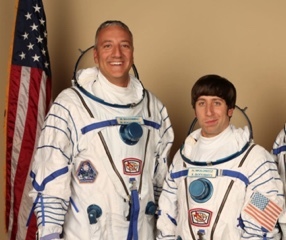 Just for comparison, this photograph looks real but is actually a fantasy
Just for comparison, this photograph looks real but is actually a fantasy
To understand the reality of what Mars really is, think of it as a corpse or a mummy. It is interesting as a former living thing and deserving of study but also somewhat repulsive.
 This is Earth...
This is Earth...
 And this is Mars.
So, just for a moment - and I'm really sorry to have to let reality intrude because Mars is a great fantasy - let's look at what Mars really is:
And this is Mars.
So, just for a moment - and I'm really sorry to have to let reality intrude because Mars is a great fantasy - let's look at what Mars really is:
• It is a tiny planet, only one third the size of Earth and only twice the size of the moon. In many ways, it's just a large dwarf planet.
• Its atmosphere is deadly poison, a very thin mix of mostly carbon dioxide. The atmospheric pressure at the top of Mount Everest in what is called the "death zone" is 5 pounds per square inch. On Mars, the maximum atmospheric pressure is .088 pounds per square inch. Even if Mars had an atmosphere of pure oxygen, it would mean a quick death for anyone who tried to breathe it.
• Mars is a dead planet. It has no magnetic field like Earth. Our magnetic field captures radiation like a shield and keeps us relatively safe from the harmful effects of all those whizzing particles.
 Golleee! I thought Mars was bigger than that!
Golleee! I thought Mars was bigger than that!
• Mars is very cold. On average, it's about 81 degrees below zero Fahrenheit. This is much colder than anywhere on Earth. Ever seen the black, ugly frostbitten toes of the climbers on Mount Everest? Let a boot warmer not work for just a few minutes and you'd have horribly frozen toes. Same goes for other parts of the body including hands. On Mars, frostbite would be a constant worry not to mention failure of the moving parts of your suit.
 You wore those boots on Mars? I told you their heaters weren't working.
You wore those boots on Mars? I told you their heaters weren't working.
Now you're going to lose all your toes! • The surface of Mars is awash with radiation that is deadly to humans. The only instrument sent to Mars to measure radiation was nearly destroyed by solar flares that would have killed within hours any Earthian mammal on Mars. Think living in Chernobyl. Not in the city. In the nuclear plant.
• Mars is very far away from the Earth in both distance and time. On average, it's about 140 million miles away. Earth and Mars do a complicated dance around the sun. Most of our robots sent there take about 10 months one way and we could expect most human missions to be the same. However, it's only every couple of years that Mars and the Earth line up so that the journey isn't longer.
• Plants can't grow in Martian soil without intensive leaching of the perchlorates out of it and the addition of vast amounts of fertilizers. In other words, Mars dirt is poisonous to Earthian plants. You can't live off the land without a huge dedicated farming effort unknown to humankind.
 The surface of Mars. It's kind of desolate. Pretty, agreed, but still deadly
The surface of Mars. It's kind of desolate. Pretty, agreed, but still deadly
OK, with these realities of what Mars is really like, let's pretend you're the manager of the team responsible to send humans to Mars. Here (vastly simplified) are your tasks.
• First, you would have to figure out to deal with the limitations of the human body outside our protective atmosphere and magnetic field. Just some of the things that would have to be overcome are these realities:
1. Prolonged weightlessness is not good for humans. As a minimum, living for months in microgravity causes loss of muscles, loss of bone calcium, possibly slows brain function, and causes eye damage. In other words, it makes you weak, your bones brittle, your thinking somewhat muddled, and fuzzy vision. Can you think of any human groups presently like this? Of course. Weightlessness makes you old before your time. Unless that's solved, sailing astronauts through space to Mars and landing them would be like placing 80-year old folks atop Mount Everest and expecting them to get out and go to work to stay alive.
2. Prolonged exposure to the radiation in space outside our magnetic field is not good for humans. Background radiation that is everywhere in open space is bad enough but undeterred cosmic rays will zap through the human body like little bullets destroying flesh, blood, and anything else that gets in its way. In ten months of exposure, unprotected humans might look normal but inside they'd be like Swiss cheese with lots of health problems on the march that would kill them.
3. Prolonged time away from assistance from other humans is not good for humans. There is a lot that can go wrong with the human body. The appendix is a good example. It can be fine one day, completely haywire the next and will kill you if you don't get it immediately surgically removed. Wintering over on the South Pole is about the closest we've ever come to separating a group of humans from everyone else in modern times. When a woman (who was a physician) was diagnosed with breast cancer there, she had to operate on herself and an emergency evacuation took place which would be impossible for anyone on a flight to Mars (or on the surface of Mars, of course). Although she survived the ordeal, the poor woman would die a few years later because the cancer had been left untreated for too long.
 Sick person on way to Mars
• Next, recognizing these human limitation problems, you would have to build the hardware, software, train your crews, and organize the Earthian support teams for the voyage. Let's see as a minimum (and again vastly simplified) what that would take:
Sick person on way to Mars
• Next, recognizing these human limitation problems, you would have to build the hardware, software, train your crews, and organize the Earthian support teams for the voyage. Let's see as a minimum (and again vastly simplified) what that would take:
1. You'd quickly realize that nothing NASA or anyone else has on the drawing boards would be adequate as a living space for humans on a 10-month journey through space. The Orion capsule that NASA keeps touting as its "beyond the moon spacecraft" would be laughable to your engineers. Orion is a death trap for any voyage longer than a couple of weeks. It couldn't begin to carry the water, air, and supplies necessary to survive the ordeal of flying for months through irradiated space.
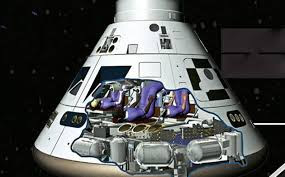 You're going to travel 140 million miles and ten months through space in that?
You're going to travel 140 million miles and ten months through space in that?
"Farewell and adieu to ye fair Spanish ladies..."
2. Something big then would have to be designed to overcome the limitations of the human body, and then tested, and then flown numerous times with test crews outside the magnetic field of Earth in order to assure that the flight is survivable. Nothing like this has ever been done. It will take an enormous effort to build this spacecraft that might provide artificial gravity (spin it?), radiation shielding (Lead? Water? Unobtainium?). You'll also need inside this ship a full medical lab, a complete pharmacy, a surgical ward, and an optics specialist that can treat eyes and make spectacles as needed.
 Hi there! You're sick, too? And we're only a million miles into this flight?
Hi there! You're sick, too? And we're only a million miles into this flight?
Thank goodness, NASA paid my way through medical school and I only have to do this once!
3. If your engineers come back to you (as they probably will) and say that ten months is just too long to fly through space, you'll have to build advanced propulsion systems such as nuclear thermal rocket engines. These do not presently exist so they will have to be built and tested and actually flown through space, preferably all the way to Mars. These might cut down the journey to a few months but, sadly, even for that smaller amount of time, you'll find you still have to provide all that medical assistance and shielding. It'll just cut down on your odds of having a disabled (or dead) crew upon arrival at Mars.
4. Somewhere along the line, one of your engineers is going to ask "How much food is the crew going to need? And water?" The answer is enormous amounts and both quite heavy. So now, you've got to design a galley and stuff your ship full of food and water. It is mindful of what the German U-boats had to do to cross the Atlantic during World War II. Every available space, even the toilet, was stuffed full of food and they still starved and some came down with scurvy. Let's say you only have a three-person crew. For a journey requiring ten months, they would need (according to the U.S. Army's field guide for soldiers in the field) about five tons of food and 25 tons of potable and 25 tons of non-potable water. Of course, you can recycle some of the water but not all so you'll need to make sure you've got that mechanism all figured out without any possibility of failure. Otherwise, you're risking your crew dying of thirst or, at best, really stinky since they won't be able to wash. Best thing, you'll realize, is carry lots of water. You've got to get back, too, so you kind of end up doubling everything. Better triple it just to be sure. Uh oh. Better get a bigger ship! And rocket!
 Eat your limes, m'boys ere ye gets the scurvy!!!
Eat your limes, m'boys ere ye gets the scurvy!!!
But we be astronauts, ain't we Cap'n?
Yeah, but ye ain't immortal. 5. How about poop? Well, you'd better put in a number of toilets and they'd better work. Poop can be slung outside and probably will be but if there's a problem and pipes get clogged, better come up with something better than they've got on the ISS which has a nasty toilet according to everyone who's had to use it. Think what it would mean to have to use a rural gas station toilet for ten months! And then another ten months!
 Yuk!
6. Uh oh! How is the crew going to get power? Solar panels? They're going to have to be huge! We're going away from the sun! Nuclear power plant? Where? How? It's got to be shielded and somebody's going have to know how to operate it. I've got it! Let's use fuel cells. Oh, wait, one of those almost killed the crew of Apollo 13. What to do, what to do? Nobody knows. Talk about engineering arguments! You'll finally just have to choose something but you realize there are going to be serious drawback to any power solution. You realize on a lot of choices you're making in the design of this big ship, you're crossing your fingers. You can't wait for vacation. You take a cruise and one of the passengers, a young person, dies of something along the way. You're stressed! That could have been one of your Mars crew! You start thinking of early retirement.
Yuk!
6. Uh oh! How is the crew going to get power? Solar panels? They're going to have to be huge! We're going away from the sun! Nuclear power plant? Where? How? It's got to be shielded and somebody's going have to know how to operate it. I've got it! Let's use fuel cells. Oh, wait, one of those almost killed the crew of Apollo 13. What to do, what to do? Nobody knows. Talk about engineering arguments! You'll finally just have to choose something but you realize there are going to be serious drawback to any power solution. You realize on a lot of choices you're making in the design of this big ship, you're crossing your fingers. You can't wait for vacation. You take a cruise and one of the passengers, a young person, dies of something along the way. You're stressed! That could have been one of your Mars crew! You start thinking of early retirement.
 People die on cruise ships. All ages. It's sad but true.
People die on cruise ships. All ages. It's sad but true.
But if you could put a ship this size in space
and send it to Mars, you might be on to something... 7. So let's say you've got your ship designed and a-building. It's a big, complex thing but you think it'll get a crew to Mars without killing them but now you realize that the crew is going to have to be trained on living in this contraption and ground crews are going to have to be trained to keep track of what's happening in it and also every facet of its systems. Checking back on your spaceflight history, you realize that the Apollo missions had tens of thousands of people on Earth who knew precisely their particular part of the Apollo capsule and lander and a thousand or so people who were fully occupied every moment of their lives with the flights that lasted a little over a week. But for Mars, you're going to have to have all these people dedicated to keeping track of every component of your spacecraft for months and years. It will be a vast, marching army that will stretch out to the horizon and somehow you're going to have to keep them trained, salaried, and happy. Nothing like it, short of war where the nation went into rationing to support its troops in the field, has ever been done. Just as D-Day was practiced and the Apollo missions were practiced, a ship to Mars is going to have to be recreated in a realistic simulator on Earth with crews spending months inside it and wave after wave of ground controllers moved in and out to their stations while simulations teams throw problem after problem at them. There will be day, evening, and night shifts and the sims will be interminable. Not every person hired will be able to take the incessant training and pressure. Constant retraining will be necessary. Finally, someone will come up with ships at sea which are monitored and maintained entirely by the crew inside. It will be tempting to get rid of ground support and just put enough crew aboard and let them go essentially on their own. But who will dare to let this happen?
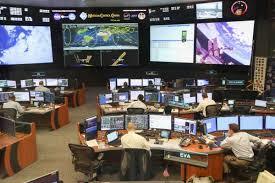 Mars Mission Control (multiply this scene by about six times in size
Mars Mission Control (multiply this scene by about six times in size
not to mention behind the scenes controllers) operating
24 hours a day for years at a time incessantly without relief
8. OK, you've got your ship a-building, your crews and ground support a-training, and then one of your pesky engineers is going to ask, "Um, what about landing and how long are they going to stay?" This will start yet another round of engineering design with lots of unknown factors. For instance, will the crew be healthy enough to land on Mars? And, if so, how to do it? Retro rockets? Parachutes? How will they get back to the mother ship? And what are they going to do to dodge all that radiation down there? What are they going to eat? What about water? Got to put tons of everything down there first... somehow. OMG!
9. So you've got a lander which has the ability to take off again - you hope. But you can't just have your crew wander around. You've got to have a habitat that shields them from the radiation and where they can eat, drink, poop, pee, and get surgery as required. So you realize you've got to ship not only food and water in advance but some place for them to live! This will mean putting that ship for the crew which was a-building on hold, and all those simulations and ground controllers on hold, and now having to construct a survivable habitat and somehow getting that to the exact place where the crew will land and then train the crews to live inside them and the ground folks to monitor them and then...
 Humongous Mars Craft of Some Sort Kind Of Maybe
Humongous Mars Craft of Some Sort Kind Of Maybe
• And THEN you're going to realize that for what it's taking to put this sad and probably sick little crew on Mars, you could've built a thousand, nay TEN THOUSAND robots capable of scouring the surface of the little planet AND by the time you've built all these contraptions and trained all these people and driven yourself and a lot of other people pretty much crazy, you could've waited until Artificial Intelligence got to the level that AI droids could even look like people and you could even kind of crawl inside these semi-people's heads and see what they see and feel what they feel. AND they don't get sick, they don't care much about radiation, and they don't eat or drink or poop or do any of the things that people do AND everything is suddenly simplified!!!
So we would go from this scenario with humans on Mars:
Mars Mission Director: Hey, what happened to Ken?
Crew Controller: He fell off a cliff and broke his arm. Compound fracture.
MMD: OMG! How is he?
CC: In emergency surgery. His arm is also infected. Doc says he'll need massive amounts of antibiotics and they're running low. He needs a blood transfusion, too. Sir, I think Ken might not make it.
MMD: Just because of a broken arm?
CC: Afraid so.
MMD: How's his significant other?
CC: Buffy is stressed out of her mind. The doc told her to rest. She took a pill and went to bed.
MMD: Can we get them out of there?
CC: Not really.
MMD: What's to be done?
CC: We probably should send along a crematorium on the next cargo flight.
MMD: I don't get paid enough for this.
CC: None of us do, sir.
 Ken broke his arm on Mars!!!
Ken broke his arm on Mars!!!
To this scenario:
Mars Mission Director: Hey, how's AI Buffy and AI Ken?
Crew Controller: AI Ken fell off a cliff yesterday and broke one of his arms. AI Buffy is replacing it with a spare.
MMD: Great. How's AI Buffy's power pack?
CC: She'll be dead in about two months but she's gone a year past her design.
MMD: Great. She going to be able to operate that well digger until then?
CC: Don't see why not. A new improved AI Buffy is on the way there to replace her, too.
MMD: Great. Carry on.
 The new AI Buffy on Mars is doing swell!
The new AI Buffy on Mars is doing swell!
And that, folks, is the sad and sorry truth on why people are not going to Mars any time soon and very possibly never. It's not that it's too hard. It just doesn't make any sense with the technology we've got, the limitations of the human body, our ability to keep ground control armies marching forever without some economic or national-survival sense to it, and the present and near-future capability of robots and artificial intelligence. Besides that, Mars just isn't the planet it's made out to be. It's a hellhole, pretty much, an interesting hellhole to be sure but not the place we need to dump so much effort into. Let's save that for the Earth-like planets around other stars. We'll get there, one way or the other, because they will be, unlike Mars, worth the time, blood, and treasure.
Oh, and I'll add one thing more. All those folks who think they really, really want to go to Mars and live should just go out to Garfield County, Montana, where I hunt dinosaurs every summer, and squat down in the badlands and spend a few months without communications with anyone and just kind of live off the land or what they've carried with them. I guarantee you by the time a few weeks are done - and most likely a few days - they'll be begging to get out of there and, compared to Mars, those marvelous badlands I love so much are positively benign.
 Me in the Montana badlands - benign compared to Mars.
Me in the Montana badlands - benign compared to Mars.
Wonderful country but not forever, thanks.
 Sooooo sorry!
Sooooo sorry!
In a previous blog, https://homerhickamblog.blogspot.com/2019/06/a-myth-known-as-mars-psst-nasas-not.html, I explained how Mars rose into the consciousness of so many people over the past century or so as a desirable place to send humans to land and live. But Mars has always been more of a myth than reality.
 Just for comparison, this photograph looks real but is actually a fantasy
Just for comparison, this photograph looks real but is actually a fantasy
To understand the reality of what Mars really is, think of it as a corpse or a mummy. It is interesting as a former living thing and deserving of study but also somewhat repulsive.
 This is Earth...
This is Earth...
 And this is Mars.
So, just for a moment - and I'm really sorry to have to let reality intrude because Mars is a great fantasy - let's look at what Mars really is:
And this is Mars.
So, just for a moment - and I'm really sorry to have to let reality intrude because Mars is a great fantasy - let's look at what Mars really is:• It is a tiny planet, only one third the size of Earth and only twice the size of the moon. In many ways, it's just a large dwarf planet.
• Its atmosphere is deadly poison, a very thin mix of mostly carbon dioxide. The atmospheric pressure at the top of Mount Everest in what is called the "death zone" is 5 pounds per square inch. On Mars, the maximum atmospheric pressure is .088 pounds per square inch. Even if Mars had an atmosphere of pure oxygen, it would mean a quick death for anyone who tried to breathe it.
• Mars is a dead planet. It has no magnetic field like Earth. Our magnetic field captures radiation like a shield and keeps us relatively safe from the harmful effects of all those whizzing particles.
 Golleee! I thought Mars was bigger than that!
Golleee! I thought Mars was bigger than that!
• Mars is very cold. On average, it's about 81 degrees below zero Fahrenheit. This is much colder than anywhere on Earth. Ever seen the black, ugly frostbitten toes of the climbers on Mount Everest? Let a boot warmer not work for just a few minutes and you'd have horribly frozen toes. Same goes for other parts of the body including hands. On Mars, frostbite would be a constant worry not to mention failure of the moving parts of your suit.
 You wore those boots on Mars? I told you their heaters weren't working.
You wore those boots on Mars? I told you their heaters weren't working.Now you're going to lose all your toes! • The surface of Mars is awash with radiation that is deadly to humans. The only instrument sent to Mars to measure radiation was nearly destroyed by solar flares that would have killed within hours any Earthian mammal on Mars. Think living in Chernobyl. Not in the city. In the nuclear plant.
• Mars is very far away from the Earth in both distance and time. On average, it's about 140 million miles away. Earth and Mars do a complicated dance around the sun. Most of our robots sent there take about 10 months one way and we could expect most human missions to be the same. However, it's only every couple of years that Mars and the Earth line up so that the journey isn't longer.
• Plants can't grow in Martian soil without intensive leaching of the perchlorates out of it and the addition of vast amounts of fertilizers. In other words, Mars dirt is poisonous to Earthian plants. You can't live off the land without a huge dedicated farming effort unknown to humankind.
 The surface of Mars. It's kind of desolate. Pretty, agreed, but still deadly
The surface of Mars. It's kind of desolate. Pretty, agreed, but still deadly
OK, with these realities of what Mars is really like, let's pretend you're the manager of the team responsible to send humans to Mars. Here (vastly simplified) are your tasks.
• First, you would have to figure out to deal with the limitations of the human body outside our protective atmosphere and magnetic field. Just some of the things that would have to be overcome are these realities:
1. Prolonged weightlessness is not good for humans. As a minimum, living for months in microgravity causes loss of muscles, loss of bone calcium, possibly slows brain function, and causes eye damage. In other words, it makes you weak, your bones brittle, your thinking somewhat muddled, and fuzzy vision. Can you think of any human groups presently like this? Of course. Weightlessness makes you old before your time. Unless that's solved, sailing astronauts through space to Mars and landing them would be like placing 80-year old folks atop Mount Everest and expecting them to get out and go to work to stay alive.
2. Prolonged exposure to the radiation in space outside our magnetic field is not good for humans. Background radiation that is everywhere in open space is bad enough but undeterred cosmic rays will zap through the human body like little bullets destroying flesh, blood, and anything else that gets in its way. In ten months of exposure, unprotected humans might look normal but inside they'd be like Swiss cheese with lots of health problems on the march that would kill them.
3. Prolonged time away from assistance from other humans is not good for humans. There is a lot that can go wrong with the human body. The appendix is a good example. It can be fine one day, completely haywire the next and will kill you if you don't get it immediately surgically removed. Wintering over on the South Pole is about the closest we've ever come to separating a group of humans from everyone else in modern times. When a woman (who was a physician) was diagnosed with breast cancer there, she had to operate on herself and an emergency evacuation took place which would be impossible for anyone on a flight to Mars (or on the surface of Mars, of course). Although she survived the ordeal, the poor woman would die a few years later because the cancer had been left untreated for too long.
 Sick person on way to Mars
• Next, recognizing these human limitation problems, you would have to build the hardware, software, train your crews, and organize the Earthian support teams for the voyage. Let's see as a minimum (and again vastly simplified) what that would take:
Sick person on way to Mars
• Next, recognizing these human limitation problems, you would have to build the hardware, software, train your crews, and organize the Earthian support teams for the voyage. Let's see as a minimum (and again vastly simplified) what that would take:1. You'd quickly realize that nothing NASA or anyone else has on the drawing boards would be adequate as a living space for humans on a 10-month journey through space. The Orion capsule that NASA keeps touting as its "beyond the moon spacecraft" would be laughable to your engineers. Orion is a death trap for any voyage longer than a couple of weeks. It couldn't begin to carry the water, air, and supplies necessary to survive the ordeal of flying for months through irradiated space.
 You're going to travel 140 million miles and ten months through space in that?
You're going to travel 140 million miles and ten months through space in that?"Farewell and adieu to ye fair Spanish ladies..."
2. Something big then would have to be designed to overcome the limitations of the human body, and then tested, and then flown numerous times with test crews outside the magnetic field of Earth in order to assure that the flight is survivable. Nothing like this has ever been done. It will take an enormous effort to build this spacecraft that might provide artificial gravity (spin it?), radiation shielding (Lead? Water? Unobtainium?). You'll also need inside this ship a full medical lab, a complete pharmacy, a surgical ward, and an optics specialist that can treat eyes and make spectacles as needed.
 Hi there! You're sick, too? And we're only a million miles into this flight?
Hi there! You're sick, too? And we're only a million miles into this flight?Thank goodness, NASA paid my way through medical school and I only have to do this once!
3. If your engineers come back to you (as they probably will) and say that ten months is just too long to fly through space, you'll have to build advanced propulsion systems such as nuclear thermal rocket engines. These do not presently exist so they will have to be built and tested and actually flown through space, preferably all the way to Mars. These might cut down the journey to a few months but, sadly, even for that smaller amount of time, you'll find you still have to provide all that medical assistance and shielding. It'll just cut down on your odds of having a disabled (or dead) crew upon arrival at Mars.
4. Somewhere along the line, one of your engineers is going to ask "How much food is the crew going to need? And water?" The answer is enormous amounts and both quite heavy. So now, you've got to design a galley and stuff your ship full of food and water. It is mindful of what the German U-boats had to do to cross the Atlantic during World War II. Every available space, even the toilet, was stuffed full of food and they still starved and some came down with scurvy. Let's say you only have a three-person crew. For a journey requiring ten months, they would need (according to the U.S. Army's field guide for soldiers in the field) about five tons of food and 25 tons of potable and 25 tons of non-potable water. Of course, you can recycle some of the water but not all so you'll need to make sure you've got that mechanism all figured out without any possibility of failure. Otherwise, you're risking your crew dying of thirst or, at best, really stinky since they won't be able to wash. Best thing, you'll realize, is carry lots of water. You've got to get back, too, so you kind of end up doubling everything. Better triple it just to be sure. Uh oh. Better get a bigger ship! And rocket!
 Eat your limes, m'boys ere ye gets the scurvy!!!
Eat your limes, m'boys ere ye gets the scurvy!!!But we be astronauts, ain't we Cap'n?
Yeah, but ye ain't immortal. 5. How about poop? Well, you'd better put in a number of toilets and they'd better work. Poop can be slung outside and probably will be but if there's a problem and pipes get clogged, better come up with something better than they've got on the ISS which has a nasty toilet according to everyone who's had to use it. Think what it would mean to have to use a rural gas station toilet for ten months! And then another ten months!
 Yuk!
6. Uh oh! How is the crew going to get power? Solar panels? They're going to have to be huge! We're going away from the sun! Nuclear power plant? Where? How? It's got to be shielded and somebody's going have to know how to operate it. I've got it! Let's use fuel cells. Oh, wait, one of those almost killed the crew of Apollo 13. What to do, what to do? Nobody knows. Talk about engineering arguments! You'll finally just have to choose something but you realize there are going to be serious drawback to any power solution. You realize on a lot of choices you're making in the design of this big ship, you're crossing your fingers. You can't wait for vacation. You take a cruise and one of the passengers, a young person, dies of something along the way. You're stressed! That could have been one of your Mars crew! You start thinking of early retirement.
Yuk!
6. Uh oh! How is the crew going to get power? Solar panels? They're going to have to be huge! We're going away from the sun! Nuclear power plant? Where? How? It's got to be shielded and somebody's going have to know how to operate it. I've got it! Let's use fuel cells. Oh, wait, one of those almost killed the crew of Apollo 13. What to do, what to do? Nobody knows. Talk about engineering arguments! You'll finally just have to choose something but you realize there are going to be serious drawback to any power solution. You realize on a lot of choices you're making in the design of this big ship, you're crossing your fingers. You can't wait for vacation. You take a cruise and one of the passengers, a young person, dies of something along the way. You're stressed! That could have been one of your Mars crew! You start thinking of early retirement. People die on cruise ships. All ages. It's sad but true.
People die on cruise ships. All ages. It's sad but true.But if you could put a ship this size in space
and send it to Mars, you might be on to something... 7. So let's say you've got your ship designed and a-building. It's a big, complex thing but you think it'll get a crew to Mars without killing them but now you realize that the crew is going to have to be trained on living in this contraption and ground crews are going to have to be trained to keep track of what's happening in it and also every facet of its systems. Checking back on your spaceflight history, you realize that the Apollo missions had tens of thousands of people on Earth who knew precisely their particular part of the Apollo capsule and lander and a thousand or so people who were fully occupied every moment of their lives with the flights that lasted a little over a week. But for Mars, you're going to have to have all these people dedicated to keeping track of every component of your spacecraft for months and years. It will be a vast, marching army that will stretch out to the horizon and somehow you're going to have to keep them trained, salaried, and happy. Nothing like it, short of war where the nation went into rationing to support its troops in the field, has ever been done. Just as D-Day was practiced and the Apollo missions were practiced, a ship to Mars is going to have to be recreated in a realistic simulator on Earth with crews spending months inside it and wave after wave of ground controllers moved in and out to their stations while simulations teams throw problem after problem at them. There will be day, evening, and night shifts and the sims will be interminable. Not every person hired will be able to take the incessant training and pressure. Constant retraining will be necessary. Finally, someone will come up with ships at sea which are monitored and maintained entirely by the crew inside. It will be tempting to get rid of ground support and just put enough crew aboard and let them go essentially on their own. But who will dare to let this happen?
 Mars Mission Control (multiply this scene by about six times in size
Mars Mission Control (multiply this scene by about six times in sizenot to mention behind the scenes controllers) operating
24 hours a day for years at a time incessantly without relief
8. OK, you've got your ship a-building, your crews and ground support a-training, and then one of your pesky engineers is going to ask, "Um, what about landing and how long are they going to stay?" This will start yet another round of engineering design with lots of unknown factors. For instance, will the crew be healthy enough to land on Mars? And, if so, how to do it? Retro rockets? Parachutes? How will they get back to the mother ship? And what are they going to do to dodge all that radiation down there? What are they going to eat? What about water? Got to put tons of everything down there first... somehow. OMG!
9. So you've got a lander which has the ability to take off again - you hope. But you can't just have your crew wander around. You've got to have a habitat that shields them from the radiation and where they can eat, drink, poop, pee, and get surgery as required. So you realize you've got to ship not only food and water in advance but some place for them to live! This will mean putting that ship for the crew which was a-building on hold, and all those simulations and ground controllers on hold, and now having to construct a survivable habitat and somehow getting that to the exact place where the crew will land and then train the crews to live inside them and the ground folks to monitor them and then...
 Humongous Mars Craft of Some Sort Kind Of Maybe
Humongous Mars Craft of Some Sort Kind Of Maybe
• And THEN you're going to realize that for what it's taking to put this sad and probably sick little crew on Mars, you could've built a thousand, nay TEN THOUSAND robots capable of scouring the surface of the little planet AND by the time you've built all these contraptions and trained all these people and driven yourself and a lot of other people pretty much crazy, you could've waited until Artificial Intelligence got to the level that AI droids could even look like people and you could even kind of crawl inside these semi-people's heads and see what they see and feel what they feel. AND they don't get sick, they don't care much about radiation, and they don't eat or drink or poop or do any of the things that people do AND everything is suddenly simplified!!!
So we would go from this scenario with humans on Mars:
Mars Mission Director: Hey, what happened to Ken?
Crew Controller: He fell off a cliff and broke his arm. Compound fracture.
MMD: OMG! How is he?
CC: In emergency surgery. His arm is also infected. Doc says he'll need massive amounts of antibiotics and they're running low. He needs a blood transfusion, too. Sir, I think Ken might not make it.
MMD: Just because of a broken arm?
CC: Afraid so.
MMD: How's his significant other?
CC: Buffy is stressed out of her mind. The doc told her to rest. She took a pill and went to bed.
MMD: Can we get them out of there?
CC: Not really.
MMD: What's to be done?
CC: We probably should send along a crematorium on the next cargo flight.
MMD: I don't get paid enough for this.
CC: None of us do, sir.
 Ken broke his arm on Mars!!!
Ken broke his arm on Mars!!!
To this scenario:
Mars Mission Director: Hey, how's AI Buffy and AI Ken?
Crew Controller: AI Ken fell off a cliff yesterday and broke one of his arms. AI Buffy is replacing it with a spare.
MMD: Great. How's AI Buffy's power pack?
CC: She'll be dead in about two months but she's gone a year past her design.
MMD: Great. She going to be able to operate that well digger until then?
CC: Don't see why not. A new improved AI Buffy is on the way there to replace her, too.
MMD: Great. Carry on.
 The new AI Buffy on Mars is doing swell!
The new AI Buffy on Mars is doing swell!
And that, folks, is the sad and sorry truth on why people are not going to Mars any time soon and very possibly never. It's not that it's too hard. It just doesn't make any sense with the technology we've got, the limitations of the human body, our ability to keep ground control armies marching forever without some economic or national-survival sense to it, and the present and near-future capability of robots and artificial intelligence. Besides that, Mars just isn't the planet it's made out to be. It's a hellhole, pretty much, an interesting hellhole to be sure but not the place we need to dump so much effort into. Let's save that for the Earth-like planets around other stars. We'll get there, one way or the other, because they will be, unlike Mars, worth the time, blood, and treasure.
Oh, and I'll add one thing more. All those folks who think they really, really want to go to Mars and live should just go out to Garfield County, Montana, where I hunt dinosaurs every summer, and squat down in the badlands and spend a few months without communications with anyone and just kind of live off the land or what they've carried with them. I guarantee you by the time a few weeks are done - and most likely a few days - they'll be begging to get out of there and, compared to Mars, those marvelous badlands I love so much are positively benign.
 Me in the Montana badlands - benign compared to Mars.
Me in the Montana badlands - benign compared to Mars.Wonderful country but not forever, thanks.
Published on July 20, 2019 13:04
June 13, 2019
A Myth Known as Mars (psst, NASA's not going there, pass it on)
Dear Readers:
Many of you know that I've recently taken NASA Administrator Jim Bridenstine and other highnesses in the agency to task for not being able to talk about plans to go back to the moon (this time to stay) without mentioning Mars in the same breath. My unhappiness over this tendency is pretty simple: Not only do I not like being told a myth unless the teller is a Tolkien type of tall tale spinner, I don't like young people to be the victim of untruths told again and again until even the non-truth sayers think they're telling the truth.
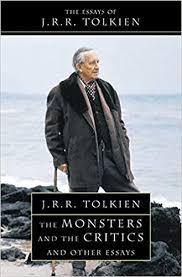 Mr. Tolkien, Myth-Teller, whose wonderful books were fiction.
Mr. Tolkien, Myth-Teller, whose wonderful books were fiction.
So here is the truth: NASA has no plans now, nor has it ever had plans, nor does it have a plan to have plans to send humans to Mars. As of right now, it isn't going, not with humans, and if you're depending on NASA to get you there, you are going to have a very long wait, sorry. I'll list below some of the things the agency would have done already if it was going to send humans to Mars and they've done none of them.
NASA Aministrator Jim Bridenstine is a very nice man and a competent manager and also very smart. I know him and admire and respect him. But if all that is so, why does he and others in NASA and nearly every person who has anything to do with human spaceflight in the federal government keep talking about going to Mars when they have orders to go to the moon? One reason is because they are victims of an illusion promoted by a billionaire astronomer - sort of a star-gazing Bernie Madoff - more than a century ago that just won't go away. Let me explain why that is as best as I am able in a very short manner which admittedly might miss a few nuances, and let me also provide evidence to you why this astronauts to Mars thing is all a hoax even though the hoaxers (including the original one) don't necessarily understand they're hoaxers and may even think they are telling the truth (bless their hearts).
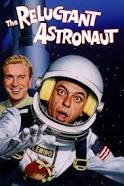 Here is Don Knotts, a fellow West Virginian, playing an astronaut
Here is Don Knotts, a fellow West Virginian, playing an astronaut
that I'm including just because...
Recently, I had cause to research for a screenplay one Clyde Tombaugh, a nerdy but persistent fellow who discovered the dwarf planet Pluto in 1929 (just in time for the Depression but hey).
 Clyde TombaughIn the process of studying Clyde's experiences, I ran across another interesting story, that of Percival Lowell and his secretary and mistress Wrexi Leonard who would become the first American female professional astronomer.
Clyde TombaughIn the process of studying Clyde's experiences, I ran across another interesting story, that of Percival Lowell and his secretary and mistress Wrexi Leonard who would become the first American female professional astronomer.
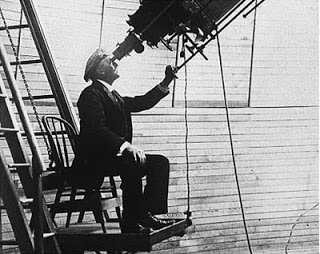 Percival Lowell at his telescope in his observatory
Percival Lowell at his telescope in his observatory
 Wrexi Leonard making her own independent observations
Wrexi Leonard making her own independent observations
at the Lowell Observatory
Dr. Lowell was a very rich member of the Lowell family, a bunch of Boston Brahmins who were rumored to only talk to the Cabots who only talked to God. His sister was a cigar-smoking poet and also an avowed Lesbian (this was during the Gilded Age when Victorian mores were still in effect so she truly didn't care what anybody thought). His brother was the President of Harvard.
 Amy Lowell, Percival's sisterWith such siblings, I guess you could say that Percival came from interesting stock. On the other hand, when you're as rich as the Lowells were, I suppose being interesting might be somewhat natural.
Amy Lowell, Percival's sisterWith such siblings, I guess you could say that Percival came from interesting stock. On the other hand, when you're as rich as the Lowells were, I suppose being interesting might be somewhat natural.
Anyway, after exploring the sexual mores of the ladies of Asia and writing titillating memoirs about his experiences, Percival decided his next pursuit of the good life was to become an astronomer. He therefore constructed the Lowell Observatory in Arizona, dragged poor Wrexi out there with him, and got to work. Before long, he discovered Mars. Well, not really, as the planet had been known since ancient times but sort of because he saw it in ways nobody had ever seen it before.
 One of Percival Lowell's many drawings of Mars
One of Percival Lowell's many drawings of Mars
Dr. Lowell (an honorary title) studied Mars every time the clouds cleared from his hilltop observatory above Scottsdale. It wasn't long before he saw some odd features on the red planet and the more he looked at them and drew them, the more he was convinced he was seeing signs of present or past intelligent life. Night after night, he drew what he saw which were lines that streaked across the planet, some of them intersecting in smudgy places as if on purpose. Before long, he was certain that what he was seeing were canals and the intersections were surely oases where the beings who had dug the canals were living. Wrexi (bless her heart) worked very hard to become a competent astronomer and also studied Mars but didn't see what her boss was seeing. Still, she kept her more accurate observations pretty much to herself and praised her Percival for his astonishing ability to see what nobody else could see. That's just the kind of woman she was but, that said, I'm pleased to report she was no passive wallflower. The Mexican and the French Astronomical societies gave her awards for her work.
But back to Percival Lowell.
Armed with what he believed was evidence of Martians building canals to transport water from the poles in order to sustain their civilization which was facing (or had faced) enormous climate change (hmmm...), Lowell wrote many books on these amazing lines and what they meant. He even went on the lecture circuit and, before long, Percival Lowell was something of a pop star of his age and Mars grew into a symbol of life on the edge that was eagerly clasped to its bosom by a repressed society which was thrilled that there was someone out there besides themselves who was probably equally miserable but had done something about it.
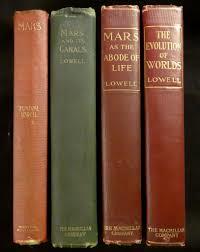 Some books, mostly about Mars, by Percival Lowell
Some books, mostly about Mars, by Percival Lowell
A careful reading of his writing (difficult as it's pretty dense stuff) shows it isn't entirely clear that Lowell believed his own hype. Actually, he saw that Europe was heading pan over skillet for the Great War and it was his hope that his Martian chronicles would demonstrate that people were better off cooperating in the face of disaster than killing one another off. Nonetheless, the Europeans saw fit to kill one another off by the millions which so disappointed Lowell that he actually died. Well, it may be that something else killed him, maybe his battleaxe of a wife since she was so jealous of Wrexi (my own theory completely devoid and utterly absent of any evidence) but nonetheless Lowell went to the great Mars in the sky, leaving his observatory to struggle on until Clyde showed up but that's another story. Wrexi, by the way, was thrown out on the street by Lowell's wife but did fine other than ending up in the poor house (literally).
 Wrexi's tombstone. She died poor and alone.Lowell's legacy was Mars, or the misunderstanding of what Mars really was, and his purplish prose about what he thought he saw spawned a vast array of fiction including Wells' War of the Worlds, Heinlein's Stranger in a Strange Land, and Bradbury's The Martian Chronicles. Mars in the minds of so many readers became sort of a mini-Earth, or a place where another Earth might rise, and where humans should aspire to go because it was, well, Mars which beckoned with open arms. Besides these literate, exciting books, there came thousands and thousands of tales in book or film form set on a fictional Mars, nearly all of it grown straight out of Percival Lowell's imagination while he peered through his telescopes atop an Arizona mountain (the canals, by the by, might have been the reflection of the veins in his eyes). Lowell's prose was so romantic and his lectures so interesting that, over time, in nearly everyone's head Mars became not what it actually was but what everyone wanted it to be.
Wrexi's tombstone. She died poor and alone.Lowell's legacy was Mars, or the misunderstanding of what Mars really was, and his purplish prose about what he thought he saw spawned a vast array of fiction including Wells' War of the Worlds, Heinlein's Stranger in a Strange Land, and Bradbury's The Martian Chronicles. Mars in the minds of so many readers became sort of a mini-Earth, or a place where another Earth might rise, and where humans should aspire to go because it was, well, Mars which beckoned with open arms. Besides these literate, exciting books, there came thousands and thousands of tales in book or film form set on a fictional Mars, nearly all of it grown straight out of Percival Lowell's imagination while he peered through his telescopes atop an Arizona mountain (the canals, by the by, might have been the reflection of the veins in his eyes). Lowell's prose was so romantic and his lectures so interesting that, over time, in nearly everyone's head Mars became not what it actually was but what everyone wanted it to be.
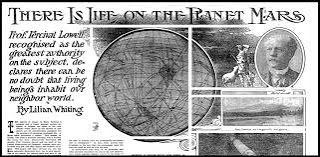 And there you go!But then came a violent correction of Lowell's Martian dreams in the form of the truth.
And there you go!But then came a violent correction of Lowell's Martian dreams in the form of the truth.
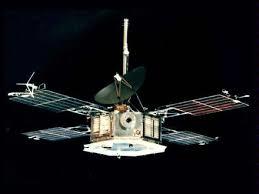 Mariner IV - Dream SlayerIn 1965, NASA' s Mariner IV flew past Mars and took photos and other measurements. What it sent back shocked scientists and lay people still awash with Lowellian dreams of a ruddy but livable world. The photographs revealed only a tortured plain of craters and dirt. Moreover, the flyby confirmed that the Martian atmosphere was only about 1% of Earth's and almost entirely carbon dioxide. The planet also had no magnetic field. In other words, Mars was a dead planet. Dead, dead, dead.
Mariner IV - Dream SlayerIn 1965, NASA' s Mariner IV flew past Mars and took photos and other measurements. What it sent back shocked scientists and lay people still awash with Lowellian dreams of a ruddy but livable world. The photographs revealed only a tortured plain of craters and dirt. Moreover, the flyby confirmed that the Martian atmosphere was only about 1% of Earth's and almost entirely carbon dioxide. The planet also had no magnetic field. In other words, Mars was a dead planet. Dead, dead, dead.
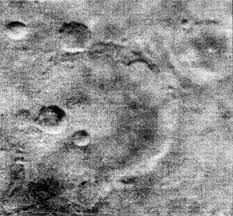 Wait a minute, Mariner IV... Can this be right? This is Mars?The midget planet (only one third the size of Earth) was now known to be nothing but a battered old red rock located far, far away but NASA (bless its heart for persistence) labored on in its study of the place but sadly now with its chastened dreams of a little globe somewhat like Earth totally crushed.
Wait a minute, Mariner IV... Can this be right? This is Mars?The midget planet (only one third the size of Earth) was now known to be nothing but a battered old red rock located far, far away but NASA (bless its heart for persistence) labored on in its study of the place but sadly now with its chastened dreams of a little globe somewhat like Earth totally crushed.
Lowell's dreamy depictions of Mars and all the fiction that had been built up around it, however, proved extremely difficult to suspend and, very soon, the ancient red corpse was being resurrected as a place where humans absolutely needed to go. This time, it was by none other than Dr. Wernher von Braun, something of a dreamer himself, who put Mars back up on its pedestal with a rhetorical stick up its back to hold it up. This, oddly enough, was because of the Apollo moon program which, after an initial rush of excitement after the first landing and the thrill of the Apollo 13 rescue, quickly lapsed below the fold in interest by a bored public.
 My cat Wyatt being bored like the American public. I am
My cat Wyatt being bored like the American public. I am
including this because he's also cute (so is the American public)As an aside, what could have happened at this point was that NASA and the American intelligentsia might have said to themselves, "You know, these Apollo flights have been great and we've learned a lot but they've kind of run their course with the present technology. Let's pause, consider what we've learned, and in the meantime slowly and responsibly build more robust systems to go to the lunar surface so that we might prosper from our success..."
 Thinking like the Thinker, a somewhat untested process in the
Thinking like the Thinker, a somewhat untested process in the
United States overall space programBut nooooo.
Before we scarcely got there, the moon flights were cancelled along with Dr. von Braun's extremely successful heavy lifting Saturn V rocket. Hurt by this rejection, the doctor latched onto Mars and waxed eloquently on it as a substitute destination. To get there, he conjured up a multi-tiered approach of building a space shuttle, then a space station, and then nuclear rocket engines that would propel twin spacecraft and their landers to the small red planet. He said to anyone who would listen that Mars was the "next moon" and so he prepared his pitch to the powers that be and it was a good one, too.
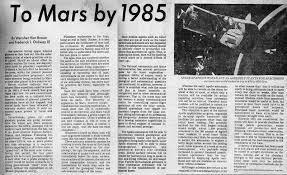 Dr. von Braun's Hail Mary Pass to MarsUnfortunately...
Dr. von Braun's Hail Mary Pass to MarsUnfortunately...
The day after Dr. von Braun made his presentation on going to Mars to Vice President Agnew (soon to resign for taking bribes) and Congress (nobody resigned even though, well, you know), Mariner VII swept by Mars and revealed, yep, Mariner IV wasn't kidding. Mars was not only dead but it was really, really dead. Von Braun was therefore summarily dismissed, his presentation tossed in the trash can, and any idea of going to Mars was forgotten.
 Thank you, Dr. von Braun.
Thank you, Dr. von Braun.
We will consider your proposal carefully - Congress.
But not really. NASA yet persevered, this time in the 1970's with two Viking spacecraft that actually landed on the dusty little planet's surface, one of the experiments even looking for signs of life. The result of that experiment was no life was found... or was it? There was some uncertainty. Over the next few decades, NASA dispatched increasingly sophisticated spacecraft to the small planet for detailed studies. These probes showed Mars to be a lot more interesting than the Mariner and even the Viking missions predicted. It was a world that had once known flowing water and still had polar ice caps, had deep canyons and giant mountains, and was geologically diverse. Moreover, little American robots with cute names began to roam the Martian surface and as they went along, they began to take on personalities and were praised for being brave and hardy and true pioneers.
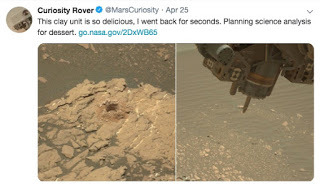 Curiosity Rover on Mars keeping it real.
Curiosity Rover on Mars keeping it real.
Percival Lowell, in sheer delight at these developments, might have sat bolt upright if he wasn't dead under a concrete slab in a mausoleum his thoroughly irritated widow put him beneath on his observatory mountain. Mars was in again! Let's go!
 Constance Lowell at Percival's Mausoleum
Constance Lowell at Percival's Mausoleum
"Hey there! How ya doin'?
I had Wrexi thrown in the street, just so you know!
I also sued your Observatory for its last dime! Have a nice death!"And so the Martian myth came alive yet again just as NASA's space shuttle program was shut down for being too expensive and too dangerous, and its International Space Station, otherwise a magnificent construction, was unfortunately, no matter how one looked at it, adding very little to science and essentially nothing to the economy and therefore needed to pitched just like Apollo was (I will resist putting another photo of The Thinker here).
But when reality fails, dreams can substitute. The Lowellian fantasy floated right back into people's heads. We need to go to Mars! Soon, children picked up on what the adults at NASA were saying and little red planets began to circle their heads. Noticing, NASA public relations folks changed We need to go to Mars! to We're going to Mars! And then after praise came their way for their declaration, there came a shazam! realization within the old agency that, to continue that praise, the leaders there didn't actually have to do the hard work of building anything to go to Mars! It only had to say it was going and people, especially young people, adored them and their agency! So they kept saying it and saying it and pretty soon the highnesses of NASA came to believe it, too. We're going to Mars!
 We're going to Mars!
We're going to Mars!
But, while they were saying it, NASA did nothing to make it a reality. Not. A. Thing.
Accepting for the moment that humans need to go to this small, reddish, essentially airless and radiation-washed planet because it's just marvelous there, what needs to be done so that we complex organisms who get sick and die on Mount Everest (Disney World compared to Mars) might actually go and live there? Well, let's list some of them and see where we are.
1. Testing of habitats large enough to sustain a crew for two years going and coming. - Nothing accomplished or even proposed.*
2. Testing of habitats that would sustain humans on an airless, radiation-washed planet for any length of time - Nothing accomplished or even proposed.
3. Testing of Martian landers. - Nothing accomplished or even proposed.
4. Testing of artificial gravity in order to ameliorate the harmful effects of long-term microgravity (use of centrifugal forces?) - Nothing accomplished or even proposed.*
5. Testing of shielding or medicine to ameliorate the harmful effects of radiation during spaceflight or the Martian surface - Nothing accomplished or even proposed.*
6. Testing of power sources on the Martian surface (nuclear and solar generators?) - Nothing accomplished but some proposals with minor funding and relaxed schedules.
7. Testing of advanced propulsion systems to ameliorate long journey across the nothingness between Earth and Mars (nuclear?) - Nothing accomplished but some proposals with minor funding and relaxed schedules.
* Could have been tested on the International Space Station but wasn't which tells the tale I'm getting at very well.
 Mars Plans? We don't have no stinkin' Mars Plans!
Mars Plans? We don't have no stinkin' Mars Plans!
I could go on but I think the point is made. NASA has accomplished essentially nothing to get ready to send humans to Mars and there is virtually nothing in the pipeline. Still and yet, they keep saying We're going to Mars! even while being ordered to instead go to the moon. Well, actually, that command has forced them to modify their battlecry by putting it this way: We're going to the moon so we can go to Mars! Uh huh, right.
By the way, not talking about Elon here. That boy might just give it a go but that's on his dime which probably has the head of Percival Lowell on it rather than President Roosevelt's. Do it, Mr. Musk. I will cheer you on. Glad you liked The Dinosaur Hunter, by the way.
 Elon reading The Dinosaur Hunter and being thoroughly amused.
Elon reading The Dinosaur Hunter and being thoroughly amused.
And speaking of me...
Just about everyone who pays the slightest bit of attention to my writing about space (a small percentage of my literary output but still...) knows that I am a hopeless human domiciliary lunaphile (that means I love the idea of people living on the moon and doesn't mean something bad) and believe that we as a civilization have much productive work scientifically and economically to do on the planet that circles us.
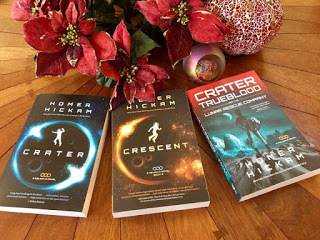 My trilogy of moon books, not counting Back to the Moon
My trilogy of moon books, not counting Back to the Moon
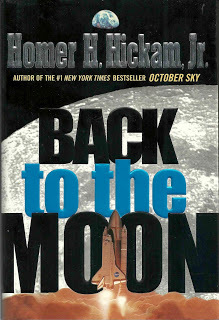 My book the Vice President likes.
My book the Vice President likes.
In fact, I believe the moon is vastly more important to us as a species than Mars will ever be. By utilizing the resources of our nearby neighbor, we can create a spacefaring civilization that, for decades to come, will be mostly back and forth between us and our newly installed lunar brethren and sisteren. But to build what we need on the moon and properly explore it, we're going to have to do a lot of work while not being distracted by that shiny Lowellian object known as Mars.
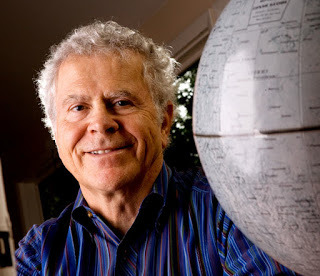 Moi and my favorite planet not counting the one I'm presently on.So, NASA and Mr. Bridenstine, sorry for being fussy but let's go to the place where we need to go for economic as well as scientific reasons and please stop saying it's only so we can go to Mars. It's a big fib and an unnecessary one at that. I absolutely believe Mars should be explored by the federal government's space agency but by robots and AI which every year get better and better and are extensions of we humans, anyway. They'll get us all the information we need and, after all, that's all you're really planning to do so let's stay real and let Dr. Lowell rest.
Moi and my favorite planet not counting the one I'm presently on.So, NASA and Mr. Bridenstine, sorry for being fussy but let's go to the place where we need to go for economic as well as scientific reasons and please stop saying it's only so we can go to Mars. It's a big fib and an unnecessary one at that. I absolutely believe Mars should be explored by the federal government's space agency but by robots and AI which every year get better and better and are extensions of we humans, anyway. They'll get us all the information we need and, after all, that's all you're really planning to do so let's stay real and let Dr. Lowell rest.
 Quote from Percival Lowell on his mausoleumBut I'm not as certain we should let Wrexi rest. That woman deserves a medal for putting up with Percival and winning honors for her astronomical work. How about a Wrexi Leonard Avenue?
Quote from Percival Lowell on his mausoleumBut I'm not as certain we should let Wrexi rest. That woman deserves a medal for putting up with Percival and winning honors for her astronomical work. How about a Wrexi Leonard Avenue?
 Miss Wrexi Leonard,
Miss Wrexi Leonard,
the first professional female astronomer in the United States
Thank you,
Homer
Many of you know that I've recently taken NASA Administrator Jim Bridenstine and other highnesses in the agency to task for not being able to talk about plans to go back to the moon (this time to stay) without mentioning Mars in the same breath. My unhappiness over this tendency is pretty simple: Not only do I not like being told a myth unless the teller is a Tolkien type of tall tale spinner, I don't like young people to be the victim of untruths told again and again until even the non-truth sayers think they're telling the truth.
 Mr. Tolkien, Myth-Teller, whose wonderful books were fiction.
Mr. Tolkien, Myth-Teller, whose wonderful books were fiction.So here is the truth: NASA has no plans now, nor has it ever had plans, nor does it have a plan to have plans to send humans to Mars. As of right now, it isn't going, not with humans, and if you're depending on NASA to get you there, you are going to have a very long wait, sorry. I'll list below some of the things the agency would have done already if it was going to send humans to Mars and they've done none of them.
NASA Aministrator Jim Bridenstine is a very nice man and a competent manager and also very smart. I know him and admire and respect him. But if all that is so, why does he and others in NASA and nearly every person who has anything to do with human spaceflight in the federal government keep talking about going to Mars when they have orders to go to the moon? One reason is because they are victims of an illusion promoted by a billionaire astronomer - sort of a star-gazing Bernie Madoff - more than a century ago that just won't go away. Let me explain why that is as best as I am able in a very short manner which admittedly might miss a few nuances, and let me also provide evidence to you why this astronauts to Mars thing is all a hoax even though the hoaxers (including the original one) don't necessarily understand they're hoaxers and may even think they are telling the truth (bless their hearts).
 Here is Don Knotts, a fellow West Virginian, playing an astronaut
Here is Don Knotts, a fellow West Virginian, playing an astronautthat I'm including just because...
Recently, I had cause to research for a screenplay one Clyde Tombaugh, a nerdy but persistent fellow who discovered the dwarf planet Pluto in 1929 (just in time for the Depression but hey).
 Clyde TombaughIn the process of studying Clyde's experiences, I ran across another interesting story, that of Percival Lowell and his secretary and mistress Wrexi Leonard who would become the first American female professional astronomer.
Clyde TombaughIn the process of studying Clyde's experiences, I ran across another interesting story, that of Percival Lowell and his secretary and mistress Wrexi Leonard who would become the first American female professional astronomer. Percival Lowell at his telescope in his observatory
Percival Lowell at his telescope in his observatory Wrexi Leonard making her own independent observations
Wrexi Leonard making her own independent observationsat the Lowell Observatory
Dr. Lowell was a very rich member of the Lowell family, a bunch of Boston Brahmins who were rumored to only talk to the Cabots who only talked to God. His sister was a cigar-smoking poet and also an avowed Lesbian (this was during the Gilded Age when Victorian mores were still in effect so she truly didn't care what anybody thought). His brother was the President of Harvard.
 Amy Lowell, Percival's sisterWith such siblings, I guess you could say that Percival came from interesting stock. On the other hand, when you're as rich as the Lowells were, I suppose being interesting might be somewhat natural.
Amy Lowell, Percival's sisterWith such siblings, I guess you could say that Percival came from interesting stock. On the other hand, when you're as rich as the Lowells were, I suppose being interesting might be somewhat natural.Anyway, after exploring the sexual mores of the ladies of Asia and writing titillating memoirs about his experiences, Percival decided his next pursuit of the good life was to become an astronomer. He therefore constructed the Lowell Observatory in Arizona, dragged poor Wrexi out there with him, and got to work. Before long, he discovered Mars. Well, not really, as the planet had been known since ancient times but sort of because he saw it in ways nobody had ever seen it before.
 One of Percival Lowell's many drawings of Mars
One of Percival Lowell's many drawings of MarsDr. Lowell (an honorary title) studied Mars every time the clouds cleared from his hilltop observatory above Scottsdale. It wasn't long before he saw some odd features on the red planet and the more he looked at them and drew them, the more he was convinced he was seeing signs of present or past intelligent life. Night after night, he drew what he saw which were lines that streaked across the planet, some of them intersecting in smudgy places as if on purpose. Before long, he was certain that what he was seeing were canals and the intersections were surely oases where the beings who had dug the canals were living. Wrexi (bless her heart) worked very hard to become a competent astronomer and also studied Mars but didn't see what her boss was seeing. Still, she kept her more accurate observations pretty much to herself and praised her Percival for his astonishing ability to see what nobody else could see. That's just the kind of woman she was but, that said, I'm pleased to report she was no passive wallflower. The Mexican and the French Astronomical societies gave her awards for her work.
But back to Percival Lowell.
Armed with what he believed was evidence of Martians building canals to transport water from the poles in order to sustain their civilization which was facing (or had faced) enormous climate change (hmmm...), Lowell wrote many books on these amazing lines and what they meant. He even went on the lecture circuit and, before long, Percival Lowell was something of a pop star of his age and Mars grew into a symbol of life on the edge that was eagerly clasped to its bosom by a repressed society which was thrilled that there was someone out there besides themselves who was probably equally miserable but had done something about it.
 Some books, mostly about Mars, by Percival Lowell
Some books, mostly about Mars, by Percival LowellA careful reading of his writing (difficult as it's pretty dense stuff) shows it isn't entirely clear that Lowell believed his own hype. Actually, he saw that Europe was heading pan over skillet for the Great War and it was his hope that his Martian chronicles would demonstrate that people were better off cooperating in the face of disaster than killing one another off. Nonetheless, the Europeans saw fit to kill one another off by the millions which so disappointed Lowell that he actually died. Well, it may be that something else killed him, maybe his battleaxe of a wife since she was so jealous of Wrexi (my own theory completely devoid and utterly absent of any evidence) but nonetheless Lowell went to the great Mars in the sky, leaving his observatory to struggle on until Clyde showed up but that's another story. Wrexi, by the way, was thrown out on the street by Lowell's wife but did fine other than ending up in the poor house (literally).
 Wrexi's tombstone. She died poor and alone.Lowell's legacy was Mars, or the misunderstanding of what Mars really was, and his purplish prose about what he thought he saw spawned a vast array of fiction including Wells' War of the Worlds, Heinlein's Stranger in a Strange Land, and Bradbury's The Martian Chronicles. Mars in the minds of so many readers became sort of a mini-Earth, or a place where another Earth might rise, and where humans should aspire to go because it was, well, Mars which beckoned with open arms. Besides these literate, exciting books, there came thousands and thousands of tales in book or film form set on a fictional Mars, nearly all of it grown straight out of Percival Lowell's imagination while he peered through his telescopes atop an Arizona mountain (the canals, by the by, might have been the reflection of the veins in his eyes). Lowell's prose was so romantic and his lectures so interesting that, over time, in nearly everyone's head Mars became not what it actually was but what everyone wanted it to be.
Wrexi's tombstone. She died poor and alone.Lowell's legacy was Mars, or the misunderstanding of what Mars really was, and his purplish prose about what he thought he saw spawned a vast array of fiction including Wells' War of the Worlds, Heinlein's Stranger in a Strange Land, and Bradbury's The Martian Chronicles. Mars in the minds of so many readers became sort of a mini-Earth, or a place where another Earth might rise, and where humans should aspire to go because it was, well, Mars which beckoned with open arms. Besides these literate, exciting books, there came thousands and thousands of tales in book or film form set on a fictional Mars, nearly all of it grown straight out of Percival Lowell's imagination while he peered through his telescopes atop an Arizona mountain (the canals, by the by, might have been the reflection of the veins in his eyes). Lowell's prose was so romantic and his lectures so interesting that, over time, in nearly everyone's head Mars became not what it actually was but what everyone wanted it to be. And there you go!But then came a violent correction of Lowell's Martian dreams in the form of the truth.
And there you go!But then came a violent correction of Lowell's Martian dreams in the form of the truth. Mariner IV - Dream SlayerIn 1965, NASA' s Mariner IV flew past Mars and took photos and other measurements. What it sent back shocked scientists and lay people still awash with Lowellian dreams of a ruddy but livable world. The photographs revealed only a tortured plain of craters and dirt. Moreover, the flyby confirmed that the Martian atmosphere was only about 1% of Earth's and almost entirely carbon dioxide. The planet also had no magnetic field. In other words, Mars was a dead planet. Dead, dead, dead.
Mariner IV - Dream SlayerIn 1965, NASA' s Mariner IV flew past Mars and took photos and other measurements. What it sent back shocked scientists and lay people still awash with Lowellian dreams of a ruddy but livable world. The photographs revealed only a tortured plain of craters and dirt. Moreover, the flyby confirmed that the Martian atmosphere was only about 1% of Earth's and almost entirely carbon dioxide. The planet also had no magnetic field. In other words, Mars was a dead planet. Dead, dead, dead. Wait a minute, Mariner IV... Can this be right? This is Mars?The midget planet (only one third the size of Earth) was now known to be nothing but a battered old red rock located far, far away but NASA (bless its heart for persistence) labored on in its study of the place but sadly now with its chastened dreams of a little globe somewhat like Earth totally crushed.
Wait a minute, Mariner IV... Can this be right? This is Mars?The midget planet (only one third the size of Earth) was now known to be nothing but a battered old red rock located far, far away but NASA (bless its heart for persistence) labored on in its study of the place but sadly now with its chastened dreams of a little globe somewhat like Earth totally crushed.Lowell's dreamy depictions of Mars and all the fiction that had been built up around it, however, proved extremely difficult to suspend and, very soon, the ancient red corpse was being resurrected as a place where humans absolutely needed to go. This time, it was by none other than Dr. Wernher von Braun, something of a dreamer himself, who put Mars back up on its pedestal with a rhetorical stick up its back to hold it up. This, oddly enough, was because of the Apollo moon program which, after an initial rush of excitement after the first landing and the thrill of the Apollo 13 rescue, quickly lapsed below the fold in interest by a bored public.
 My cat Wyatt being bored like the American public. I am
My cat Wyatt being bored like the American public. I amincluding this because he's also cute (so is the American public)As an aside, what could have happened at this point was that NASA and the American intelligentsia might have said to themselves, "You know, these Apollo flights have been great and we've learned a lot but they've kind of run their course with the present technology. Let's pause, consider what we've learned, and in the meantime slowly and responsibly build more robust systems to go to the lunar surface so that we might prosper from our success..."
 Thinking like the Thinker, a somewhat untested process in the
Thinking like the Thinker, a somewhat untested process in theUnited States overall space programBut nooooo.
Before we scarcely got there, the moon flights were cancelled along with Dr. von Braun's extremely successful heavy lifting Saturn V rocket. Hurt by this rejection, the doctor latched onto Mars and waxed eloquently on it as a substitute destination. To get there, he conjured up a multi-tiered approach of building a space shuttle, then a space station, and then nuclear rocket engines that would propel twin spacecraft and their landers to the small red planet. He said to anyone who would listen that Mars was the "next moon" and so he prepared his pitch to the powers that be and it was a good one, too.
 Dr. von Braun's Hail Mary Pass to MarsUnfortunately...
Dr. von Braun's Hail Mary Pass to MarsUnfortunately...The day after Dr. von Braun made his presentation on going to Mars to Vice President Agnew (soon to resign for taking bribes) and Congress (nobody resigned even though, well, you know), Mariner VII swept by Mars and revealed, yep, Mariner IV wasn't kidding. Mars was not only dead but it was really, really dead. Von Braun was therefore summarily dismissed, his presentation tossed in the trash can, and any idea of going to Mars was forgotten.
 Thank you, Dr. von Braun.
Thank you, Dr. von Braun.We will consider your proposal carefully - Congress.
But not really. NASA yet persevered, this time in the 1970's with two Viking spacecraft that actually landed on the dusty little planet's surface, one of the experiments even looking for signs of life. The result of that experiment was no life was found... or was it? There was some uncertainty. Over the next few decades, NASA dispatched increasingly sophisticated spacecraft to the small planet for detailed studies. These probes showed Mars to be a lot more interesting than the Mariner and even the Viking missions predicted. It was a world that had once known flowing water and still had polar ice caps, had deep canyons and giant mountains, and was geologically diverse. Moreover, little American robots with cute names began to roam the Martian surface and as they went along, they began to take on personalities and were praised for being brave and hardy and true pioneers.
 Curiosity Rover on Mars keeping it real.
Curiosity Rover on Mars keeping it real.Percival Lowell, in sheer delight at these developments, might have sat bolt upright if he wasn't dead under a concrete slab in a mausoleum his thoroughly irritated widow put him beneath on his observatory mountain. Mars was in again! Let's go!
 Constance Lowell at Percival's Mausoleum
Constance Lowell at Percival's Mausoleum"Hey there! How ya doin'?
I had Wrexi thrown in the street, just so you know!
I also sued your Observatory for its last dime! Have a nice death!"And so the Martian myth came alive yet again just as NASA's space shuttle program was shut down for being too expensive and too dangerous, and its International Space Station, otherwise a magnificent construction, was unfortunately, no matter how one looked at it, adding very little to science and essentially nothing to the economy and therefore needed to pitched just like Apollo was (I will resist putting another photo of The Thinker here).
But when reality fails, dreams can substitute. The Lowellian fantasy floated right back into people's heads. We need to go to Mars! Soon, children picked up on what the adults at NASA were saying and little red planets began to circle their heads. Noticing, NASA public relations folks changed We need to go to Mars! to We're going to Mars! And then after praise came their way for their declaration, there came a shazam! realization within the old agency that, to continue that praise, the leaders there didn't actually have to do the hard work of building anything to go to Mars! It only had to say it was going and people, especially young people, adored them and their agency! So they kept saying it and saying it and pretty soon the highnesses of NASA came to believe it, too. We're going to Mars!
 We're going to Mars!
We're going to Mars!But, while they were saying it, NASA did nothing to make it a reality. Not. A. Thing.
Accepting for the moment that humans need to go to this small, reddish, essentially airless and radiation-washed planet because it's just marvelous there, what needs to be done so that we complex organisms who get sick and die on Mount Everest (Disney World compared to Mars) might actually go and live there? Well, let's list some of them and see where we are.
1. Testing of habitats large enough to sustain a crew for two years going and coming. - Nothing accomplished or even proposed.*
2. Testing of habitats that would sustain humans on an airless, radiation-washed planet for any length of time - Nothing accomplished or even proposed.
3. Testing of Martian landers. - Nothing accomplished or even proposed.
4. Testing of artificial gravity in order to ameliorate the harmful effects of long-term microgravity (use of centrifugal forces?) - Nothing accomplished or even proposed.*
5. Testing of shielding or medicine to ameliorate the harmful effects of radiation during spaceflight or the Martian surface - Nothing accomplished or even proposed.*
6. Testing of power sources on the Martian surface (nuclear and solar generators?) - Nothing accomplished but some proposals with minor funding and relaxed schedules.
7. Testing of advanced propulsion systems to ameliorate long journey across the nothingness between Earth and Mars (nuclear?) - Nothing accomplished but some proposals with minor funding and relaxed schedules.
* Could have been tested on the International Space Station but wasn't which tells the tale I'm getting at very well.
 Mars Plans? We don't have no stinkin' Mars Plans!
Mars Plans? We don't have no stinkin' Mars Plans!I could go on but I think the point is made. NASA has accomplished essentially nothing to get ready to send humans to Mars and there is virtually nothing in the pipeline. Still and yet, they keep saying We're going to Mars! even while being ordered to instead go to the moon. Well, actually, that command has forced them to modify their battlecry by putting it this way: We're going to the moon so we can go to Mars! Uh huh, right.
By the way, not talking about Elon here. That boy might just give it a go but that's on his dime which probably has the head of Percival Lowell on it rather than President Roosevelt's. Do it, Mr. Musk. I will cheer you on. Glad you liked The Dinosaur Hunter, by the way.
 Elon reading The Dinosaur Hunter and being thoroughly amused.
Elon reading The Dinosaur Hunter and being thoroughly amused.And speaking of me...
Just about everyone who pays the slightest bit of attention to my writing about space (a small percentage of my literary output but still...) knows that I am a hopeless human domiciliary lunaphile (that means I love the idea of people living on the moon and doesn't mean something bad) and believe that we as a civilization have much productive work scientifically and economically to do on the planet that circles us.
 My trilogy of moon books, not counting Back to the Moon
My trilogy of moon books, not counting Back to the Moon
 My book the Vice President likes.
My book the Vice President likes.In fact, I believe the moon is vastly more important to us as a species than Mars will ever be. By utilizing the resources of our nearby neighbor, we can create a spacefaring civilization that, for decades to come, will be mostly back and forth between us and our newly installed lunar brethren and sisteren. But to build what we need on the moon and properly explore it, we're going to have to do a lot of work while not being distracted by that shiny Lowellian object known as Mars.
 Moi and my favorite planet not counting the one I'm presently on.So, NASA and Mr. Bridenstine, sorry for being fussy but let's go to the place where we need to go for economic as well as scientific reasons and please stop saying it's only so we can go to Mars. It's a big fib and an unnecessary one at that. I absolutely believe Mars should be explored by the federal government's space agency but by robots and AI which every year get better and better and are extensions of we humans, anyway. They'll get us all the information we need and, after all, that's all you're really planning to do so let's stay real and let Dr. Lowell rest.
Moi and my favorite planet not counting the one I'm presently on.So, NASA and Mr. Bridenstine, sorry for being fussy but let's go to the place where we need to go for economic as well as scientific reasons and please stop saying it's only so we can go to Mars. It's a big fib and an unnecessary one at that. I absolutely believe Mars should be explored by the federal government's space agency but by robots and AI which every year get better and better and are extensions of we humans, anyway. They'll get us all the information we need and, after all, that's all you're really planning to do so let's stay real and let Dr. Lowell rest. Quote from Percival Lowell on his mausoleumBut I'm not as certain we should let Wrexi rest. That woman deserves a medal for putting up with Percival and winning honors for her astronomical work. How about a Wrexi Leonard Avenue?
Quote from Percival Lowell on his mausoleumBut I'm not as certain we should let Wrexi rest. That woman deserves a medal for putting up with Percival and winning honors for her astronomical work. How about a Wrexi Leonard Avenue? Miss Wrexi Leonard,
Miss Wrexi Leonard,the first professional female astronomer in the United States
Thank you,
Homer
Published on June 13, 2019 16:24
May 28, 2019
A short discussion of the Core Stage of the SLS and my novels Back to the Moon/Crater
Since my blog is read by the readers of Goodreads.com, I find it always a good idea to include some reference to one or more of my books no matter what I'm writing about. Since I am about to explain what the situation is with a great big rocket that NASA is trying to build, let me just say everybody not interested in this rather esoteric commentary should just read my wonderfully literate (and often funny) novels Back to the Moon and the marvelous trilogy (literate, funny, all) that began with Crater and then continued with Crescent followed by The Lunar Rescue Company (the title of which is such because I couldn't think of another word related to the moon that began with a C although I was sure I would when I started, go figure). You can read about them and my other books here: www.homerhickam.com.

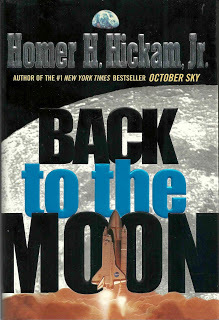
Now, with my GoodReads readers taken care of, let me explain in condensed fashion the problem with the core stage of the Space Launch System, aka SLS.
The core stage, which is really the first stage, of this great big rocket is designed to utilize the external tank (ET) of the old space shuttle. This is because Congress required that NASA use components from the shuttle to build the SLS which must have seemed the right thing to do at the time. After all, here was a big rocket that already worked - the space shuttle and all. Just move its parts around a little bit, slap a new name on it, and away you go.*
With orders to turn the ET into a booster stage, the engineers assigned to it saw that they were going to subject the tank to forces that was outside the scope of its original design. The ET was a marvel in engineering but it was supposed to take side mount forces (i.e., be dragged upward), not be pushed from below with a heavy load on top. In terms of forces, this is the difference between throwing a beer can (very little force on it other than flying through the air) and placing it upright on the ground and squashing it with the heel of your boot. Just like the beer can, the core stage is going to be crushed from above by the heavy upper stages while being shoved really hard from the bottom by multiple engines.
Faced with the requirement to build a rocket utilizing components outside their original design and function, SLS engineers responded by putting in more bracing. However, there is another force, much more insidious, that will come into play. Vibration. The two five-segment solid rocket motors strapped to the core stage is going to shake it like the San Francisco earthquake. Essentially a somewhat brittle aluminum egg, it's difficult to predict what will happen no matter how much extra support is added.
And then there's the friction-stir welds.
Friction-stir welds are not an unknown as NASA has been doing such welds for a long time and SpaceX has, too. They've just never experienced as much force and vibration on such welds before. SpaceX is a nice, smooth ride since all its engines are liquid. As mentioned before, a 5-segment stretch SRB is going to shake the bejesus out of the core stage and those welds. Again, how much vibration the core stage will receive is not entirely understood. That's why vibration tests were done in Huntsville. Computer models are also being run. Sadly, ultimately, the only way to find out the real answer is to fly the blame thing.
Another problem has to do with heat around the base. The ET, while being very strong, was thermally very fragile. Witness the Challenger. When a flame played around its base, it melted right through. On the SLS, the base of the core stage is going to receive a hotfoot by the engines strapped to its bottom. To protect it, extra shielding is needed down there. How much is required is not entirely understood. That's the reason for the so-called green test at Stennis.
So there it is in a nutshell, the problems Boeing and NASA have to solve on the SLS core stage, mainly because they didn't start with a clean sheet. If they had, their core stage would have probably looked a whole lot like a wide-body Falcon 9.
My recommendation from the get-go when the Vice President decided we were going back to the moon was to take the SLS out of the critical path to the moon and develop it to where it could be mothballed and brought into service if truly needed later for a push to Mars. But NASA seems to want it, no matter what, and that's the reality. If the agency is going to have it, then it better make it safe and not cut corners.
The one thing we don't want is some NASA engineer saying to Boeing the equivalent of what it once said to Thiokol right before the Challenger launch: "My God, Boeing, when do you want me to launch - next year?"
Well, if NASA doesn't know with some high degree of confidence what's going to happen when the button is pushed, the answer should only be, "Why, yes. Yes, we do."
* As an aside for you history buffs, Ford did that very thing with the Edsel building it on the chassis of the already-existing Fairlane and Galaxie.
Published on May 28, 2019 22:27
March 28, 2019
Back to the Moon: A Novel - My crystal ball account of the future which is now today
I wrote Back to the Moon: A Novel in 1998 and it was published by Delacorte/Random House in 1999. http://homerhickam.com/project/back-to-the-moon/

This is a portion of the final chapter. Although SSTO hasn't happened, I think there's at least some similarity to what is happening today. Moondog is very similar to Falcon Heavy. Big Dog could be the BFR. Jack Medaris could be that fellow from PayPal. My crystal ball wasn't entirely clear twenty plus years ago but it wasn't so cloudy, either.
Back to the Moon is also Vice President Pence's favorite space book. He read it when it first came out. Maybe it influenced him a little, I wouldn't know.
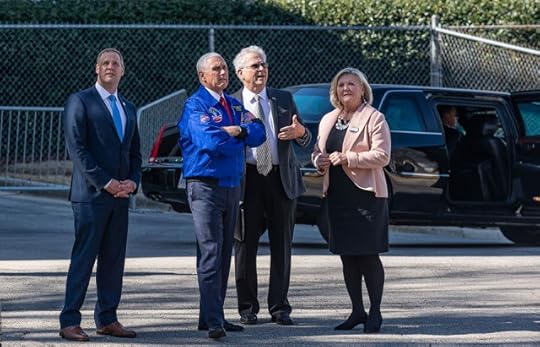 "Yes, Mr. Vice President, I think Jack Medaris and Penny High Eagle got married..."
"Yes, Mr. Vice President, I think Jack Medaris and Penny High Eagle got married..."------------------------------------------------------------------------------------------------------
Back to the Cape
It was a perfect day for a launch. The Cape sparkled in golden light as the sun peeked above the dark blue horizon, illuminating a single white puffy cloud hanging high in the sky. The crowd of dignitaries stood at the base of pad 39-B and admired the rocket sitting on its own squared-off base. It looked larger than it was because it sat by itself on the concrete pad. The gigantic towers of the shuttle era were gone. Only a small portable gantry, now rolled back, was needed for this machine, the first of the operational single-stage-to-orbit (SSTO) fleet fielded in three years of intensive effort and remarkable economy.
A siren wailed and the crowd tensed. Launch was imminent. A loudspeaker crackled beside the stands. "Ladies and Gentlemen, I give you the Medaris Engineering Company's Single Stage to Orbit vehicle, Moondog!"
Flames immediately erupted at the base of the rocket and it powered smoothly off the pad, swept up into the sky and disappeared within seconds. A thin cloud of water vapor, its only residue, hung in the air and then began to disperse in the light winds. The crowd oohed and ahhed appropriately and applauded enthusiastically. The doors on a concrete hangar beside the pad opened and a rail car, carrying another Moondog SSTO, crept out and started trundling toward the pad. "The second Moondog will be erected and ready for launch in thirty minutes," the woman over the loudspeaker said. "Powerful, safe, and economical, Moondogs are available for immediate lease. Terms are available."
Jack Medaris shook some hands, stepped down from the viewing platform. He looked with pride at his accomplishment, the Moondog reusable SSTO. His company had gone public and accomplished the design and construction of the Moondog using funds from the sale of its stock. In effect, a vast number of Americans had decided to risk their capital on Medaris's enterprise A cluster of five Big Dog engines provided the boost to get the composite aerodynamic shell and the heavy cargo aboard a Moondog into orbit. Once there and its payloads deployed, a Moondog automatically reentered and landed back at the Cape or wherever it was ordered, tail-first. A quick once-over and refueling and she was ready to go again. After a few more test flights, the Federal Aviation Administration was scheduled to clear Moondogs to be launched from anywhere in the United States. Jack's plan was to keep a fleet of six of them at the Cape to take advantage of the trained work force there.
Since Medaris's audacious trip to the moon, there had been many changes at NASA. NASA had gotten out of the operations business and moved into the forefront of research and development, handing over its scientific and engineering knowledge to American commercial space operators. With the data it had gained from the shuttle tests, the agency already had a prototype scram-jet that could fly into orbit from Edwards Air Force Base, deposit a payload, and return. NASA fielded the prototype for a half-billion dollars, ten times less than the original estimate. That estimate had been made before MEC, by taking Columbia to the moon, had demonstrated what could be done with a little money and a lot of engineering guts. The scram-jet looked good, and the older and larger aerospace companies around the world waited eagerly to get their hands on it. But Jack was convinced his Moondog design would beat the scram in head-to-head competition. Or perhaps there might be room for more than one SSTO spacecraft. The commercial markets that had opened up since his moon flight were going to be too big for a single enterprise. It was as if that flight had opened some sort of mental floodgate. The possibility that so much could be done if the will was there to do it was energizing not only to the aerospace field but in all the scientific and even political disciplines. There were new starts everywhere. Anything was possible. And it didn't have to break the bank to do it.
Medaris watched the group of VIP's, all potential customers, excitedly watch the erection of the second Moondog. With cheap access to space just on the horizon, commercial enterprises were making plans to produce a great number of products in space - new materials, new medicines, and new concepts such as tourism, space sports, and even homesteading. Jack intended that MEC would be able to provide the transportation to space they required. Industrial Orbital Facility, Inc., a private joint Japanese-American company that had taken over the old International Space Station, announced that it would launch a new man-tended laboratory the following year aboard an improved Japanese H-2D booster. Competitive bids were being taken from the clamoring companies for room aboard the module. There was renewed hope among people paralyzed by spinal cord trauma and disease that space research would deliver a cure.
There were mining outfits represented by the men and women filing into the stand to observe the launch. The interest in helium-3 had quickly reached fever pitch as soon as Dr. Perlman had come up into the bright sunlight of the Montana summer. Using the thirty kilos of beads found at Shorty crater and rescued from the Cayman trench, Perlman had demonstrated the full power of his plant. Montana Power & Light was working overtime to string in lines to it for commercial use. Energy companies the world over were flocking to the United States to learn more. The President of the United States, a year after Columbia's landing, agreed to make the technology of fusion power available to the world. Helium-3 had became the new gold of the solar system and mining companies were lining up to dig it out.
There were government officials from several countries observing Jack's Moondog flight. The moon treaties of a previous era had been revoked and governments across the earth had staked out claims. The United States and Russia made the first, based on their landings there, but other nations - England, Germany, France, Brazil, India, Japan, China, even Portugal recalling a past history of exploration and colonization - asked for and received territory set aside on the moon. An international agency was organized at the United Nations to act as an arbiter of the claims. If the land wasn't secured by a crewed landing within twenty years, it would be auctioned to the highest bidder with the proceeds going into an international spaceflight general pool. Some people were already calling this as yet unnamed international agency by a familiar name: Star Fleet.
Jack knew his company was in a good position to take commercial advantage of both the commercial and political activities. A Moondog could carry a Big Dog aloft and place it into a parking orbit. All a nation or a company needed to do was to put its mooncraft in orbit, dock with the Big Dog, and then use it to reach escape velocity. There was a great land rush coming a quarter of a million miles away from earth across the Armstrong Sea...
------------------------------------------------------------------------------------------------------
And what began with Back to the Moon was continued with my Crater Trueblood/Helium-3 series that envisions what life on the moon will be like a hundred years from now. Even though they're illegal, there will be gillies. Go here if you want to catch up with the future:
http://homerhickam.com/project/crater/
http://homerhickam.com/project/crescent-a-helium-3-novel/
http://homerhickam.com/project/helium-3-series/

Published on March 28, 2019 10:22
March 13, 2019
1993 Study of a Moon Laboratory by Homer Hickam

----------------------
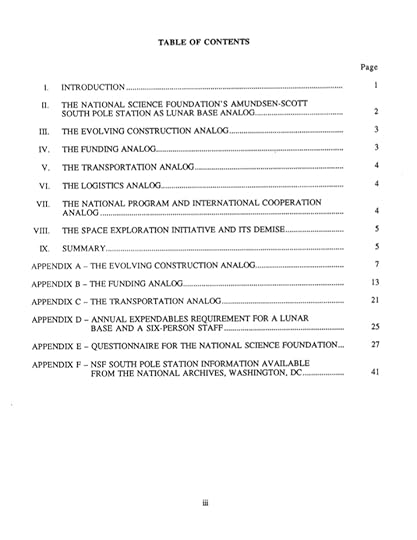
----------------------------
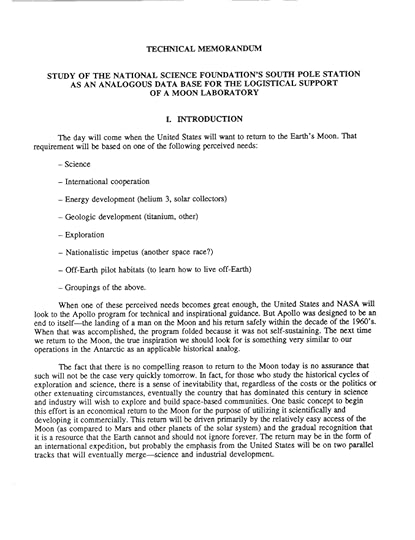
-----------------------
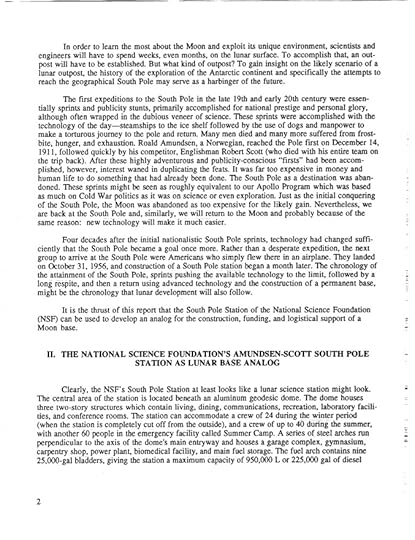 ---------------------------
---------------------------
 ---------------------------
---------------------------
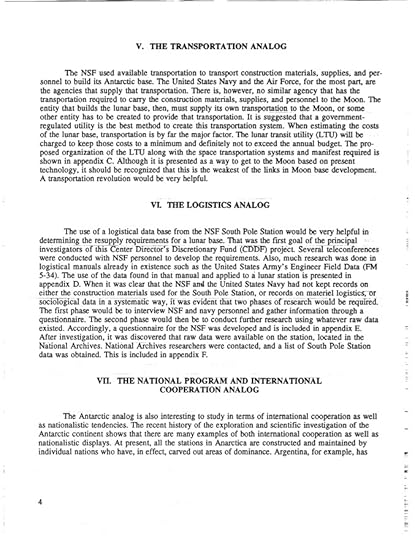 --------------------
--------------------
 ----------------------
----------------------

----------------------
------------------------------
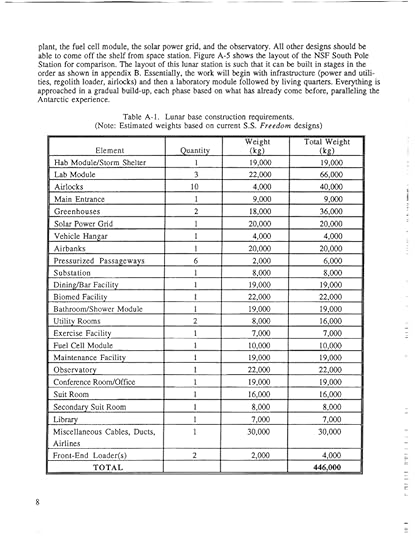


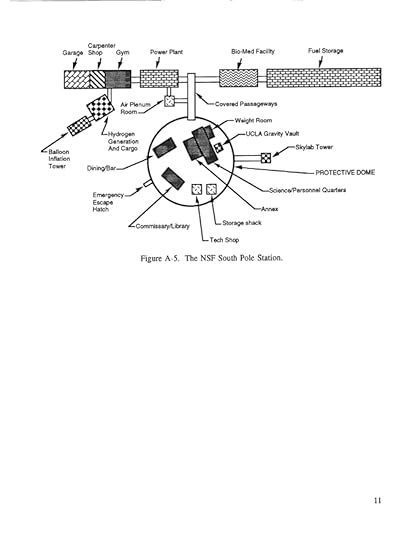



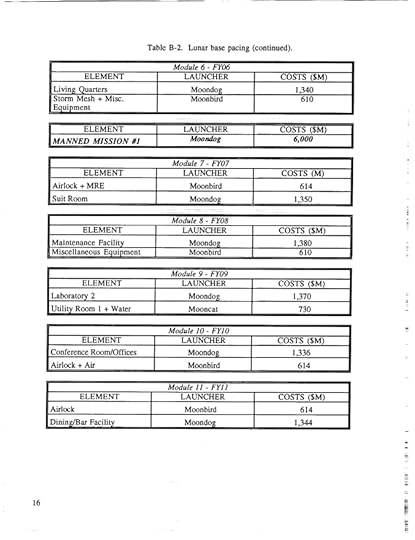
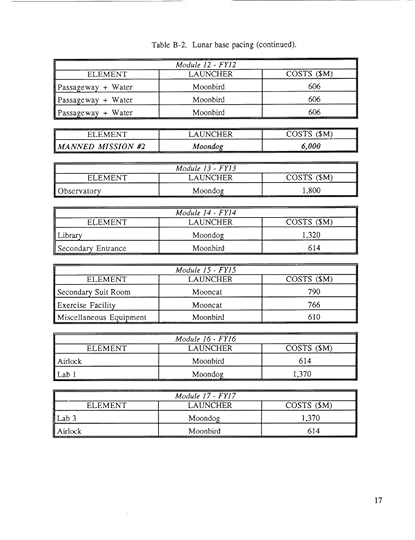




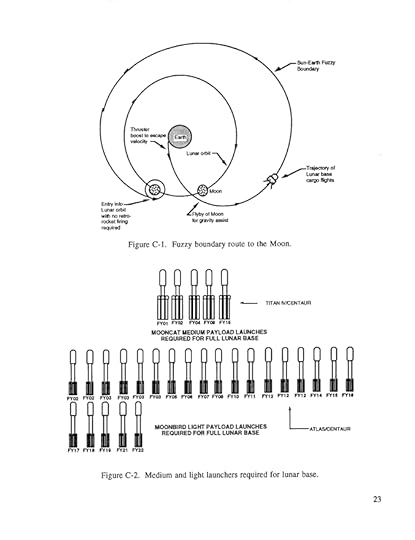
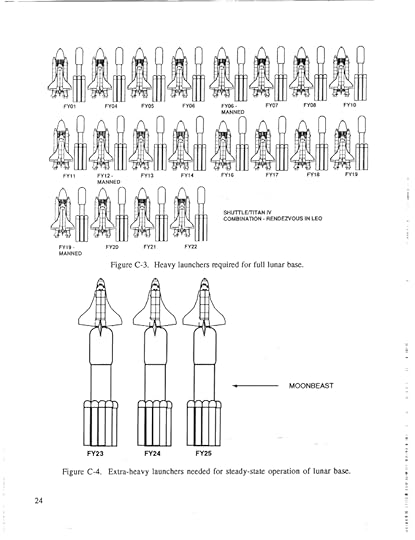


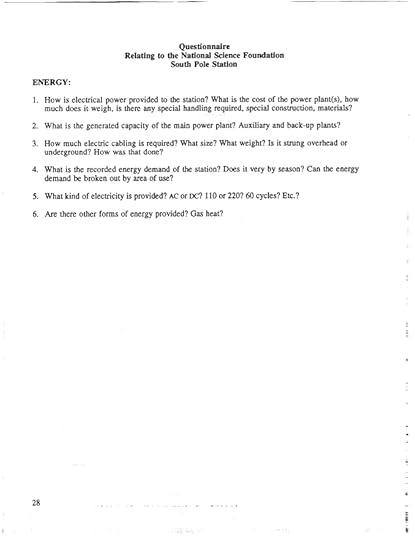
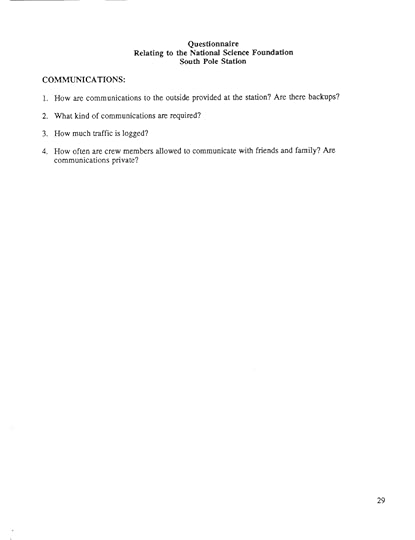


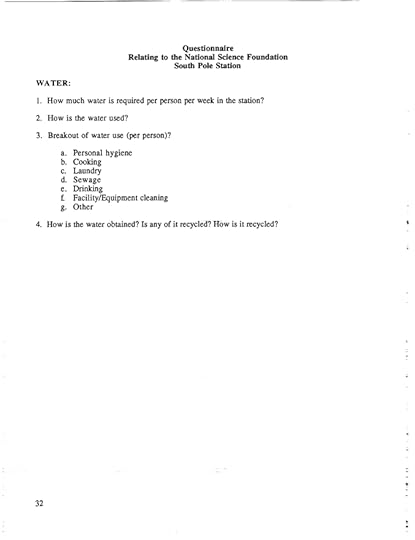
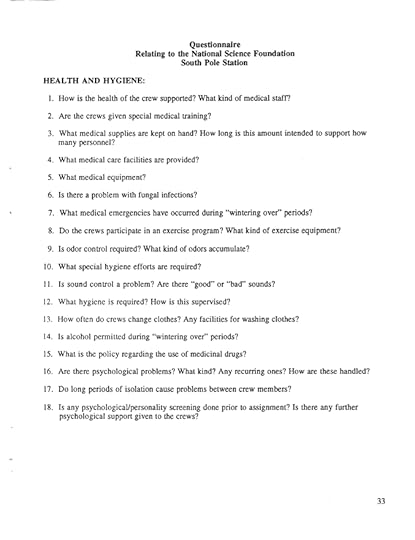


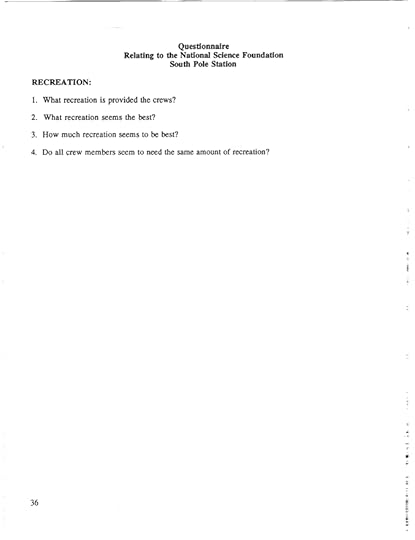

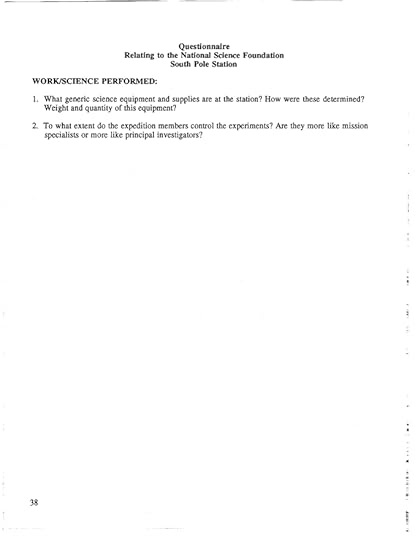


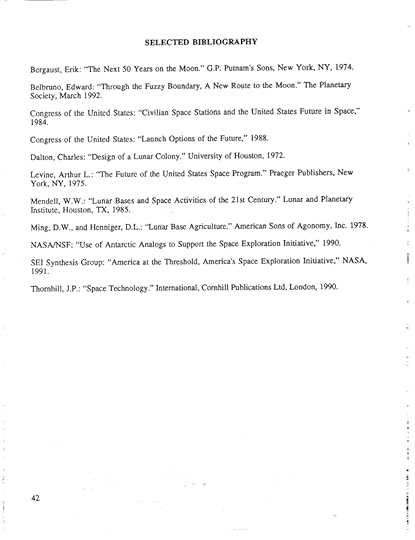

Published on March 13, 2019 08:17
February 21, 2019
Excerpt from Homer Hickam's novel CRATER about the fate of the Apollo 11 Landing Site
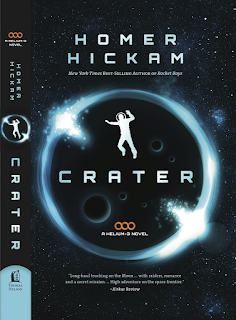
Crater walked out of the dustlock into the most amazing place he’d ever seen, the main corridor of the bustling marketplace of the moon’s largest town. Maria was still dealing with the Armstrong City clerks and inspectors who’d emerged from the airlock to register the convoy, tax the heel-3 canisters aboard, and assist in their further transport. She also had to attend to the handling of Captain Teller’s body, including seeing his family. Crater wanted to see Teller’s family, too, but there was an urgent message for him to go to the Medaris Mining company offices and meet a representative sent from the Colonel. In the dustlock, the Armstrong City dusties insisted that he remove his Deep Space BCP suit with the explanation that the biotechnology had not been approved by the city health department. Crater didn’t mind removing it—the sheath was pretty dusty, after all—and the hot water showers afterwards felt very good. He headed for the company office but before he got there, the Sheriff of Moontown appeared out of the crowd, took him by the arm, and turned him around. “We have to be careful, Crater! There may be assassins.” Crater was surprised to see the sheriff. “How did you get here?” “Jumpcar,” he said. “The Colonel had a visitor and I hitched a ride.” That sounded awfully convenient to Crater, but the sheriff seemed sincere. So he let himself be led to a ticket counter which had a sign that said See the Site of Humankind’s First Landing on the Moon. There were photos of the American astronauts Armstrong, Collins, and Aldrin for sale along with other souvenirs, including models of the Apollo capsule and the Eaglelander. The sheriff handed over an adequate number of johncredits and the clerk handed back two paper tickets. “Let’s hurry. We don’t want to miss the tram,” the sheriff said. The sheriff pointed at a dustlock which said Tours to Tranquility Base Landing Site. They went through it, emerging into a pressurized tram filled with tourists. “Welcome,” the tour guide said. “I hope you enjoy your excursion to Tranquility Base.” The sheriff pointed at two empty seats and he and Crater sat down. The tram pulled out, following a well-used track, while the tour guide announced that only one mile away was the landing site of Apollo 11, the place where humans first walked on an “astronomical body.” Calling the moon an “astronomical body” was something of an insult to Crater but he didn’t say anything, just looked out the window at the boring view which was mostly devoid of craters or anything else other than a mildly sloping plain of pebbly dust. Before long, the bus arrived at the famous landing site which was lit up by big spotlights. The tourists immediately started to take pictures. Crater gazed with some wonder at the truncated base of the landing craft called Eagle. Beside it was the American flag on a staff stuck into the dust. The flag was a recreation, of course, since the original flag had been knocked down when the upper half of the Eagle had taken off and, over the years, bleached white by the relentless sun. The tour guide had already exhausted his spiel on how close Armstrong had come to aborting the mission because of an overworked guidance computer, and how the brave American had landed anyway, completing the promise of the long-dead and little known President Kennedy who had ordered the landing to occur before the Russians could get to it. The guide was Russian so he proceeded to tell the tourists that, of course, the Russians had launched the world’s first earth satellite called Sputnik, and also launched the first person into space whose name was Yuri Gagarin. He also went on to say that during the civil war, poor Gagarin’s body had gone missing from the Kremlin during an attack by Siberian revolutionaries, but that was neither here nor there. The tour guide next turned to what had happened to the Apollo 11 landing site in the years following the landing. He mentioned the outrage in the provinces comprising the old United States of America that had occurred when a Chinese robot on tracks had barged into the site and destroyed many of the footprints while also knocking over some of the experiments left behind. A mission by the Independent States of America, which claimed the Apollo sites since it included among its member states Texas, Florida, and Alabama—where much of the Apollo hardware had been designed and built—studied the site to see if it could be reconstructed. One of its interesting findings was that it wasn’t the Chinese who had destroyed Armstrong’s famous “first step for man, giant leap for mankind” boot print but Astronaut Buzz Aldrin, who had inadvertently stepped on it as he climbed off the ladder of the landing craft. While the tourists clicked their photos, the sheriff said, “I have your ticket for the elevator and the Cycler.” “I hope whatever is in that package is worth Captain Teller’s life,” Crater said. The sheriff took a moment, then said, “I guess nothing’s worth that.” “The crowhoppers were after me.” The sheriff looked incredulous. “You shouldn’t take these things so personally. The Colonel has many enemies. There might be any number of reasons why his convoy was attacked.” “Then why did you mention assassins?” The sheriff shrugged. “I’m a cautious man.”
Published on February 21, 2019 08:59
February 15, 2019
Answers to questions from an Iranian engineering student
NOTE: I was asked by an Iranian engineering student to please answer some questions for a magazine at his university. I agreed. The Iranian people are, in my opinion, pretty wonderful. I was happy to answer his questions and hope that the future of Iran will find it once more a free and open society.
- Homer Hickam
Dear Mr. Hickam, this written interview’s aim is to know you better and introduce you to our university as a successful writer and engineer, working in NASA.We would appreciate your consideration over these questions.
Best regards
Could you introduce yourself , please? (I know there are many introductions of you in Wikipedia and other websites, but I want to know how you introduce yourself.)
**** I am Homer Hickam, the author of many best-selling books, both fiction and non-fiction. This includes My Dream of Stars, the memoir of Anousheh Ansari. I was raised in the small coal mining town of Coalwood, West Virginia in the heart of the Appalachian mountains. My father, grandfather, and great grandfather on both sides of the family were coal miners. My ancestors first came to North America in the early 1700's so we've been here for a long time. By DNA, I am English, Irish, German, Danish, Spanish, and even a little bit African American. I graduated from Virginia Tech with a degree in Industrial Engineering in 1964, served in the army during the Vietnam War, worked for the Army Missile Command in Alabama, the 7th Army Training Command in Germany, and then for NASA at the Marshall Space Flight Center in Huntsville, Alabama. I am best known for my memoir Rocket Boys that was made into the movie October Sky. I am also an avid amateur paleontologist with two T.rexes to my credit, a scuba instructor, and own homes and property in the U.S. Virgin Islands and Honduras. I spend most of my time at our home in Alabama. I am the chairman of the board of the Space and Rocket Center where Space Camp is located. I am 76 years old. I am married but have no children. Our volunteer work includes working for organizations that take care of cats and dogs needing adoption.
Lets start asking you about your masterpiece "Rocket Boys" . when did you begin writing it and what did encourage you to write?
* I think the answer is : "When Smithsonian Air & Space Magazine challenged me to write an article of 1,500 words overnight, an artifact of my boyhood days was sitting on my desk as a paperweight and caught my eye. It was a rocket nozzle built in the machine shops of Coalwood, West Virginia. My dad had saved it for me during all those years and when he died, I got it back. I, therefore, wrote an article about those events, something I hadn’t thought about for years. When it was published shortly afterwards, my phone almost melted down from calls from New York publishers and Hollywood. Was I, they asked, going to write a book about this? Well, I said, I am now!"
**** That answer is a good summation. However, I had already written another well-received book in 1989 titled Torpedo Junction, the true story of the battle against the German U-boats along the American coasts during World War II so I was already well known to book publishers. That made it easier to get Rocket Boys published.
I read somewhere that you said : The book and the movie (October Sky) are different. how much do you think they are different?and why did Hollywood change the real story?
( sorry but because of boycott we can't find your books up to 1000 Miles far away here. and we just watched the movie. the price of "rocket boys" book for buying from Europe is about expenditures a month of my family. so how ever i like to read your books ,but i can’t.)
**** I don't like to point out the differences if you've only seen the film. Otherwise, it might seem disappointing to you. A screenplay is a much different art form than a book. A movie has only 90 minutes or so to tell a story while a writer can take as long as he/she likes to write a novel or memoir. Inevitably, there are differences. I suppose the main one with Rocket Boys and October Sky is that our rockets were much more sophisticated than shown and also it took three years of development work where the movie made it over a much shorter period. Also, the science fairs were not our motivating factor. It was only when we were nearing high school graduation we decided to enter the fairs because our teacher Miss Riley wanted us to try. There were no scholarships but we all went to college, either by first going into the military to get a scholarship or, in my case, by my parents helping me and by me working in the coal mines during summers to raise extra money.
As far as I know you published your newest book about your family's alligator Albert by the name of "carrying Albert home". so after this , what is your next book about? is there any next one?
**** There will be a next one. I can't talk about it yet. Publishers don't like that.
People are not interested of space stories as much as some years ago.Now they prefer reading stories about quantum physics more than space-related subjects in scientific genre. do you have any plans to use this field (quantum physics) and its mysteries in your next book?
**** No.
Let me ask about NASA. How difficult and how fantastic can it to be work in NASA?
**** When I worked for NASA, every day I woke up and said to myself, "Oh boy! I get to go to work at NASA today!" I enjoyed the work very much. I spent many months in Japan training the first Japanese astronauts, worked as a diver in the neutral buoyancy simulator, wore the suit to practice underwater the Hubble Space Telescope repair missions before the astronauts tried the procedures, and helped design the Spacelab and set up all the astronaut training still being used for the International Space Station. It was a lot of fun.
By your opinion which field of aerospace will make the future of this science?
**** For the aero part of aerospace, I think supersonic passenger and freight transports of some kind are inevitable but I'm not sure how that will evolve. As for space, artificial intelligence will become very important. I also foresee the moon as the most important of space destinations for humans and, eventually, we will see mining there. I wrote a trio of young adult books about what life will be like on the moon. They are titled Crater, Crescent, and The Lunar Rescue Company. Space medicine is just in its infancy so much work to be done there. Ultimately, I hope to see plumbers, carpenters, electricians, miners, and lots of blue collar workers in space living, working, and raising their families. It is my further hope that a new civilization and culture will rise there. I don't expect it to be perfect. I expect it to be rough, pioneering, and at times desperate but ultimately triumphant.
What was the most surprising thing you had ever encountered in your engineering carrier?
**** That I never used a slide rule! I surely used one a lot in college. You won't have that experience, I'm sure.
Have you ever participated in or been the manager of a project which is related to guns and war machines in NASA? or you just working on the shuttle's mission and peaceful things? what's your feeling about it?
**** I am a Vietnam veteran of the 4th Infantry Division and was there during 1967-68, the bloodiest time of the entire war. It convinced me war is never the answer to anything except misery and more war. I am not a pacifist but war is no video game. It's an awful and cruel and miserable thing and people get hurt, experience excruciating pain, and if they don't die, carry the scars for the rest of their lives. After the war, I worked for the U.S. Army as a civilian engineer but not on weapons but mostly computers and programming and such. While I worked for NASA, I never worked on anything of a military nature. NASA is a civilian organization by law.
Which part of you is bigger? writer part or engineer part? could you explain more, please?
**** Now, writer. Then, engineer. I always wanted to be both and managed to accomplish my dreams of success in both fields. I never saw any conflict between them. To be a good engineer, you really must also learn to write well. One of the requirements of engineering is being able to express your ideas, both written and through speaking, in such a way to convince others you are going in the correct direction. Engineering is rarely an individual process. Nearly always, you are part of a team and have to learn how to be a good leader and also a good follower. However, an engineer must always question what is being done, especially if he sees a better way... and there is nearly ALWAYS a better way.
At first, I wanted to ask you whether "do you still see your Rocket boys friends?" , But then I found out you have an anniversary event, called " Rocket boys festival" in September2019 . Would you explain it more please?
**** Yes. Please go to www.rocketboysfestival.com for more information on that. There were actually six rocket boys. Five of us are still alive. Quentin rarely comes to the festival but Roy Lee, O'Dell, and Billy (not in the movie) usually show up. It's always good to see them.
Lets talk about a wonderful woman, whom you wrote the book "My dream" about her, Anousheh Ansari. How do you know her? And what encouraged you to write this book?
(I will be so thankful if you tell us a good memory about Anousheh Ansari.)
**** Ah, Anousheh! One of my favorite people in the world. I read somewhere she was only a few days from being launched to the space station so, on a whim, I sent her an email wishing her luck and she wrote back! When she got back from space, she contacted me, we met and I asked her if she'd like to write her memoir and, if so, could I help her with it. She said yes. She's a wonderful person. I will include a couple of photos of us. One is in front of the grave of Miss Baker, a famous monkey who flew into space. The other is in my Huntsville neighborhood trying out some devices called Trikkes which are good exercise!


At last, what would you say to young aerospace engineering students as an advice in starting this way!
**** It's good to hitch your wagon to a healthy horse. In other words, choose wisely your employer and then try to get an experienced engineer that you respect to mentor you. Listen more than you talk at first. If you can, eventually you'll want to lead your own company. But always never forget, especially in aerospace, your duty to the people who will fly aboard your machines. Keep them safe but get them there!
thank you very much for spending time with us.
**** Hope this was helpful. Please give my best to your family and friends.
Homer
www.homerhickam.com
- Homer Hickam
Dear Mr. Hickam, this written interview’s aim is to know you better and introduce you to our university as a successful writer and engineer, working in NASA.We would appreciate your consideration over these questions.
Best regards
Could you introduce yourself , please? (I know there are many introductions of you in Wikipedia and other websites, but I want to know how you introduce yourself.)
**** I am Homer Hickam, the author of many best-selling books, both fiction and non-fiction. This includes My Dream of Stars, the memoir of Anousheh Ansari. I was raised in the small coal mining town of Coalwood, West Virginia in the heart of the Appalachian mountains. My father, grandfather, and great grandfather on both sides of the family were coal miners. My ancestors first came to North America in the early 1700's so we've been here for a long time. By DNA, I am English, Irish, German, Danish, Spanish, and even a little bit African American. I graduated from Virginia Tech with a degree in Industrial Engineering in 1964, served in the army during the Vietnam War, worked for the Army Missile Command in Alabama, the 7th Army Training Command in Germany, and then for NASA at the Marshall Space Flight Center in Huntsville, Alabama. I am best known for my memoir Rocket Boys that was made into the movie October Sky. I am also an avid amateur paleontologist with two T.rexes to my credit, a scuba instructor, and own homes and property in the U.S. Virgin Islands and Honduras. I spend most of my time at our home in Alabama. I am the chairman of the board of the Space and Rocket Center where Space Camp is located. I am 76 years old. I am married but have no children. Our volunteer work includes working for organizations that take care of cats and dogs needing adoption.
Lets start asking you about your masterpiece "Rocket Boys" . when did you begin writing it and what did encourage you to write?
* I think the answer is : "When Smithsonian Air & Space Magazine challenged me to write an article of 1,500 words overnight, an artifact of my boyhood days was sitting on my desk as a paperweight and caught my eye. It was a rocket nozzle built in the machine shops of Coalwood, West Virginia. My dad had saved it for me during all those years and when he died, I got it back. I, therefore, wrote an article about those events, something I hadn’t thought about for years. When it was published shortly afterwards, my phone almost melted down from calls from New York publishers and Hollywood. Was I, they asked, going to write a book about this? Well, I said, I am now!"
**** That answer is a good summation. However, I had already written another well-received book in 1989 titled Torpedo Junction, the true story of the battle against the German U-boats along the American coasts during World War II so I was already well known to book publishers. That made it easier to get Rocket Boys published.
I read somewhere that you said : The book and the movie (October Sky) are different. how much do you think they are different?and why did Hollywood change the real story?
( sorry but because of boycott we can't find your books up to 1000 Miles far away here. and we just watched the movie. the price of "rocket boys" book for buying from Europe is about expenditures a month of my family. so how ever i like to read your books ,but i can’t.)
**** I don't like to point out the differences if you've only seen the film. Otherwise, it might seem disappointing to you. A screenplay is a much different art form than a book. A movie has only 90 minutes or so to tell a story while a writer can take as long as he/she likes to write a novel or memoir. Inevitably, there are differences. I suppose the main one with Rocket Boys and October Sky is that our rockets were much more sophisticated than shown and also it took three years of development work where the movie made it over a much shorter period. Also, the science fairs were not our motivating factor. It was only when we were nearing high school graduation we decided to enter the fairs because our teacher Miss Riley wanted us to try. There were no scholarships but we all went to college, either by first going into the military to get a scholarship or, in my case, by my parents helping me and by me working in the coal mines during summers to raise extra money.
As far as I know you published your newest book about your family's alligator Albert by the name of "carrying Albert home". so after this , what is your next book about? is there any next one?
**** There will be a next one. I can't talk about it yet. Publishers don't like that.
People are not interested of space stories as much as some years ago.Now they prefer reading stories about quantum physics more than space-related subjects in scientific genre. do you have any plans to use this field (quantum physics) and its mysteries in your next book?
**** No.
Let me ask about NASA. How difficult and how fantastic can it to be work in NASA?
**** When I worked for NASA, every day I woke up and said to myself, "Oh boy! I get to go to work at NASA today!" I enjoyed the work very much. I spent many months in Japan training the first Japanese astronauts, worked as a diver in the neutral buoyancy simulator, wore the suit to practice underwater the Hubble Space Telescope repair missions before the astronauts tried the procedures, and helped design the Spacelab and set up all the astronaut training still being used for the International Space Station. It was a lot of fun.
By your opinion which field of aerospace will make the future of this science?
**** For the aero part of aerospace, I think supersonic passenger and freight transports of some kind are inevitable but I'm not sure how that will evolve. As for space, artificial intelligence will become very important. I also foresee the moon as the most important of space destinations for humans and, eventually, we will see mining there. I wrote a trio of young adult books about what life will be like on the moon. They are titled Crater, Crescent, and The Lunar Rescue Company. Space medicine is just in its infancy so much work to be done there. Ultimately, I hope to see plumbers, carpenters, electricians, miners, and lots of blue collar workers in space living, working, and raising their families. It is my further hope that a new civilization and culture will rise there. I don't expect it to be perfect. I expect it to be rough, pioneering, and at times desperate but ultimately triumphant.
What was the most surprising thing you had ever encountered in your engineering carrier?
**** That I never used a slide rule! I surely used one a lot in college. You won't have that experience, I'm sure.
Have you ever participated in or been the manager of a project which is related to guns and war machines in NASA? or you just working on the shuttle's mission and peaceful things? what's your feeling about it?
**** I am a Vietnam veteran of the 4th Infantry Division and was there during 1967-68, the bloodiest time of the entire war. It convinced me war is never the answer to anything except misery and more war. I am not a pacifist but war is no video game. It's an awful and cruel and miserable thing and people get hurt, experience excruciating pain, and if they don't die, carry the scars for the rest of their lives. After the war, I worked for the U.S. Army as a civilian engineer but not on weapons but mostly computers and programming and such. While I worked for NASA, I never worked on anything of a military nature. NASA is a civilian organization by law.
Which part of you is bigger? writer part or engineer part? could you explain more, please?
**** Now, writer. Then, engineer. I always wanted to be both and managed to accomplish my dreams of success in both fields. I never saw any conflict between them. To be a good engineer, you really must also learn to write well. One of the requirements of engineering is being able to express your ideas, both written and through speaking, in such a way to convince others you are going in the correct direction. Engineering is rarely an individual process. Nearly always, you are part of a team and have to learn how to be a good leader and also a good follower. However, an engineer must always question what is being done, especially if he sees a better way... and there is nearly ALWAYS a better way.
At first, I wanted to ask you whether "do you still see your Rocket boys friends?" , But then I found out you have an anniversary event, called " Rocket boys festival" in September2019 . Would you explain it more please?
**** Yes. Please go to www.rocketboysfestival.com for more information on that. There were actually six rocket boys. Five of us are still alive. Quentin rarely comes to the festival but Roy Lee, O'Dell, and Billy (not in the movie) usually show up. It's always good to see them.
Lets talk about a wonderful woman, whom you wrote the book "My dream" about her, Anousheh Ansari. How do you know her? And what encouraged you to write this book?
(I will be so thankful if you tell us a good memory about Anousheh Ansari.)
**** Ah, Anousheh! One of my favorite people in the world. I read somewhere she was only a few days from being launched to the space station so, on a whim, I sent her an email wishing her luck and she wrote back! When she got back from space, she contacted me, we met and I asked her if she'd like to write her memoir and, if so, could I help her with it. She said yes. She's a wonderful person. I will include a couple of photos of us. One is in front of the grave of Miss Baker, a famous monkey who flew into space. The other is in my Huntsville neighborhood trying out some devices called Trikkes which are good exercise!


At last, what would you say to young aerospace engineering students as an advice in starting this way!
**** It's good to hitch your wagon to a healthy horse. In other words, choose wisely your employer and then try to get an experienced engineer that you respect to mentor you. Listen more than you talk at first. If you can, eventually you'll want to lead your own company. But always never forget, especially in aerospace, your duty to the people who will fly aboard your machines. Keep them safe but get them there!
thank you very much for spending time with us.
**** Hope this was helpful. Please give my best to your family and friends.
Homer
www.homerhickam.com
Published on February 15, 2019 15:11
January 23, 2019
The Power of Love: A Story of Coalwood
The Power of LovebyHomer Hickam
When I was a boy, my mother overheard me say, "I love peanut butter." I was saying it because I was having an intellectual discussion with a friend of mine, a boy who also loved peanut butter and we wished to confirm our proclivity for that most wholesome of jarred elixir. For most boys who grew up in the West Virginia coalfields, this was a natural thing to say because we sincerely believed peanut butter was just about the best thing that could possibly be smeared between two slices of white bread. Life, however, was never easy when you were the son of Elsie Hickam. Later, when she had me to herself, she admonished, "You do not lovepeanut butter," she apprised me. "You like peanut butter. Loveis a word you should use for people. For instance, you love me." "I do?" The question sprang forth thoughtlessly from my young mouth because, actually, I'd never really given it any thought as to whether I loved my mother or not. Mom's hazel eyes registered hurt. "Don't you?" Well, of course I did, especially now that she'd put it that way. To her apparent relief, I said so even though her advice still confused me. Love was just a word, right? I was to learn not so. One day, a fellow arrived in Coalwood. He was a junior engineer, those pitiful and pitiable creatures the steel company that owned our coal mine and our town sent to us from time to time to be trained in the ways of our world. Since I was at the time the owner, editor, and primary reporter for a rag I grandly called The Coalwood News, I approached him as he stood in the street and identified myself as myself. "Is this the bachelor quarters?" he asked, nodding toward the grand facility before him. "It's the Club House," I said, marveling at his ignorance of our structures, "where rooms are allotted for various workers and if you're a bachelor I guess it will do since it houses a splendid cook named Wilma." "You use big words," he apprised me. "What are you, eight years old?" "Nine," I informed him and took out my pencil and paper. "Your name and purpose for being here?" "Frank Miles. I'm an engineer. Why are you writing that down?" "I told you about my newspaper and you're officially news," I replied. "And you're not an engineer. You're a junior engineer. It takes a lot to get the rank of engineer around here. Tell me a little about yourself." "About myself? Well, right this minute, I'm hungry." He provided me a wan smile on his otherwise unhappy face. When I didn't smile at his little joke, for it was very little, he apprised me, with an odd weariness, that he'd recently been a pilot in the United States Air Force serving in the war in Korea. "Did you shoot down a MiG?" I asked, holding my pencil at the ready. He pulled up the collar on his cracked leather jacket which I presumed he'd stolen from the Air Force. "I guess I'll go on in. Good to meetcha, Sonny." He'd chosen not to answer my question but I let it go. Whatever he'd done in Korea would come out soon enough. The people of Coalwood would see to that. Sure enough, I learned everything there was to know about Frank Miles in the coming weeks. He had indeed shot down a MiG whereupon the Chinese had returned the favor, shooting him down and generally making him the wreck he turned out to be. I heard all about him from listening in on the coal miners discussing him at the company store. They were pretty unforgiving. After all, they depended on everybody at the mine to do their jobs and nervous ones made them nervous, too. The way it got back to me was that Frank's hands often shook and loud sounds made him jump, and he drank far too much of the illegal whiskey John Eye Blevins made up Snake Root Hollow. No one in town gave him much of a chance of ever doing anything worthwhile, not in Coalwood or anywhere else. In short, he was doomed without half trying. I happened to be there when the next thing happened. Frank met a young woman by the name of Teresa Donatello. Teresa was the daughter of Alfred and Ducet Donatello who'd, not so long ago, had arrived in our coal camp from the country of Italy where, I was confident from the patient instruction of my teachers, the city of Rome was located and was also, due to God's little joke, shaped in the form of a boot. Otherwise, I didn't know too much else about the place. The thing about Teresa was she was dying. Her heart was paper thin, according to the company doctor, and she was so weak she could hardly stand and there was nothing to be done. She was young, not more than eighteen, but the sands of her time were rapidly draining from the glass of life she'd been given. As soon as their eyes met, Frank and Teresa made a connection. I felt it even through my nine year old brain. Frank put down the soft drink he was raising to his lips at the company drug store and removed his hat. Teresa smiled demurely and ordered a soft drink for herself. He spoke, she spoke, and then she laughed and then he laughed. I got closer to hear what was being said but it wasn't much, just how do you do and I'm doing fine and how are you enjoying Coalwood and I guess I like it fine and that kind of stuff. How those words would make Teresa giggle and Frank's face light up like a flaming candle, I surely didn't know. Frank paid Teresa court, as required by both the rules of Coalwood and her Italian parents. He came with flowers, plucked with permission from my mother's rose garden, and sat on the porch swing and there they spoke of many things, still secret from even the ace reporter that I was at the time. Frank stopped drinking and he stopped shaking and he stopped being anything but a good man. When Teresa felt strong enough, he walked her to church and there he sat with her while the choir sang and the light streamed through the windows across our congregation who sang all the heartier in praise of the divine since two people who needed each other were in their midst. She died suddenly, Teresa, never waking one morning. Her father walked to the Club House to give Frank the news, catching him just as he walked outside to go to work. Frank walked back to the little company house and there he sat beside Teresa's bed and held her hand until the men arrived with the stretcher to take her to Doc's office where she would be prepared for burial in our little cemetery. Frank stayed in Coalwood for a few more years after that although a day didn't pass while he was still with us but what he didn't go to Teresa's grave, there to sit with her and tell her of his day, and all the things that was happening in town. He asked permission from my mom to take a slip of one of her rose bushes and plant it alongside the grave. He no longer shook or drank or did anything but what he was supposed to do. He was respected by all in the town. I wrote up a little story on it but when I showed it to her, Mom said I shouldn't print it. "It isn't our story," she said. "It's theirs and it's too fresh. Let it rest for now." I let it rest. Until now. The cemetery in Coalwood is abandoned these days, as is much of the town. A few overturned tombstones can be found amongst the trees that have grown up there to shelter that which was and never will be again. On a recent journey to my old hometown, I climbed the hill to see what was to be seen. It was as I described, nothing much left, until my eye found a spot of color. I walked to it, there to discover a most surprising artifact. It was a rose bush turned wild and unruly but with scarlet buds yet shining forth with the power of love.
Published on January 23, 2019 09:36
December 23, 2018
Excerpt from The Coalwood Way - A Christmas Miracle begins...
THE COALWOOD WAYbyHomer Hickam
Chapter 31
A Page from Jeremiah
I woke on the couch. It was morning. I remembered bringing Dad home and Mom gathering him in. "Good Lord, Homer," she said and then walked him upstairs. Quentin was asleep in my bed, Daisy Mae curled up between his legs. I retreated to the couch.
I'd had a nightmare. I had dreamed I was asleep and all around me was turmoil, things breaking, curses, and then a huge crash. I looked around and, in the light of the early dawn filtering through the living room windows, I saw that the Christmas tree was inside, more or less erect in its stand. It was tilting at an odd angle but it was there. Then I noticed Jim was sitting across from me on Dad's footstool. Billy Rose was also there, in a chair beside the tree. I thought I was still dreaming. I closed my eyes. When I opened them, both boys were still there. "What?" I demanded.
"Look," Jim said and showed me his finger.
I found my glasses. Jim's finger tip was bloody. It looked as if he'd been bitten by a snake. "What happened?"
"I just wanted a Christmas tree," he said. "So I figured I would go ahead and put it up on my own. I got out this morning and saw Billy walking down the road."
Billy said, "I was coming to your house, anyway. I thought maybe I could shovel snow or do some kind of chore for your mother."
"I asked Billy to help me with the tree and we got it inside."
"There was a bird in it," Billy said.
"We spent a good part of the last hour chasing it. I finally chased it out the back door."
That explained the noises in my dream. "Did the bird bite you?"
Jim shook his head. "No, after it went outside, I came back in here and Billy said he heard another bird rustling in the tree. I reached inside to scare it out."
"Was it a bird?"
"No."
"A snake?"
"No. Worse."
Both my eyes and brain were still bleary. "What?"
He pointed to the coffee table where the mangled Hickam family Bible
rested. It was open and on it sat something fuzzy and gray. A page had been torn from the Bible and the thing seemed to be eating it. I blinked again and then I knew what the thing was. "Chipper!"
 Chipper enjoys a Christmas snack (yes, this is the real Chipper)
Chipper enjoys a Christmas snack (yes, this is the real Chipper)At his name, the little squirrel squawked and jumped to the top of the couch, ran along it, and leaped for the curtains where it swung, its half-tail jerking spasmodically. "I think he's been living in that tree for awhile," Jim mused.
"That would explain why Mom's birdseed got eaten up so fast," I said.
"Chipper!" It was Mom, come down from upstairs to see about the commotion. She was dressed in her housecoat. Chipper stopped fussing and threw himself down on the floor and zipped up Mom's robe and then on top of her head, digging a nest in her hair. "My little boy," she said, delighted.
 Chipper looketh out at the snow on the day he returneth
Chipper looketh out at the snow on the day he returnethI had my eyes focused enough to look at the Bible. Chipper had eaten an entire page from Jeremiah. "Jim and Billy found Chipper," I said, giving credit (or blame) where credit (or blame) was due.
"He bit me," Jim said, unhappily. Billy just grinned a proud grin.
"Thank you, Jimmie. And thank you, too, Billy. I just can't thank you enough."
Chipper came down out of Mom's hair and into her arms where she held him like a baby, his little paws curling happily. "My little boy, my little boy," she crooned to him. "I know you've been far, far away but you just had to come home to me, didn't you? You never gave up, did you?"
Jim and I looked at each other and shrugged. The Hickam family, for better or worse, was back together again. The Prodigal Squirrel returneth.
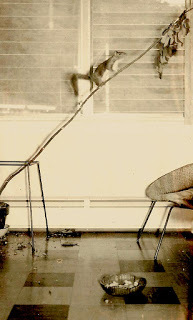 Chipper looks for something to destroy (bless him) Mom looked up from Chipper, then at Jim and me. "What day is it?" she asked.
Chipper looks for something to destroy (bless him) Mom looked up from Chipper, then at Jim and me. "What day is it?" she asked."Why, Christmas Eve," Jim said.
She crossed to the Captain's porch and put a critical eye on the outside world. The snow had stopped but it had piled up over the fence. The road was covered with it, too. "The Starvation Army won't come," she said grimly. "They won't be able to get over the mountain." She took a deep breath. Chipper jumped up on her shoulder, his little rat face taking on a look of studied concentration. Mom's face did, too, although she didn't look like a rat. She just looked tired but as I watched, there was a transformation. It seemed to me that she began to glow, as if an inner fire that had been damped down had burst again into flame.
"Jimmie," she said, "I want you to go find Jake Mosby. Most likely, he's either still at the mine or down at the Club House. Wherever you find him, roust him out and tell him he needs to get the road cleared to Welch. Tell him he owes me and if he wants to argue with me about it, he can do it later but otherwise we don't have time for his usual foolishness. Tell him the Starvation Army is coming to Coalwood and he needs to clear a path for them, no matter what it takes."
"Yes ma'am," Jim said.
"Put chains on the Buick so you can get around."
"Yes ma'am."
"When you finish with Jake, get back here. I've got to get over to Welch. You're the best driver in Coalwood. If anybody can get me there, it's you."
"Yes ma'am. I'll get Jake and then I'll drive you to Welch." Jim spoke with fierce determination. He grabbed his coat and headed outside.
"I want to help, too, Mrs. Hickam," Billy said. "I'll shovel you a path to Welch if that's what it takes."
"Thank you, dear," she said. "I believe you."
I felt left out. "What can I do?" I asked.
"I can't use a quitter," she said.
"I don't think I'm a quitter anymore," I replied, softly.
"I'm not surprised. You boys don't know a thing about quitting. I
guess you haven't seen enough of it to learn."
Mom looked out at the tipple. A towering plume of steam rose from
the shaft and climbed through the man-hoist, curling and spreading until it disappeared into the layer of thick white clouds that covered the valley. She shook her head and crossed her arms as if she were cold. "Some things need quitting, though. Not many, but some. You just got to know the difference."
She faced Billy and me and her lips were pressed together in that way she had when she'd made up her mind about something. "But that's for another time."
She pondered the undecorated Christmas tree. "You two want to know what you can do? I'll tell you. Do the impossible. It seems like a good day for it."
I puzzled over her words and then I knew what Mom wanted me to do. It was impossible, of course, but I couldn't wait to do it.
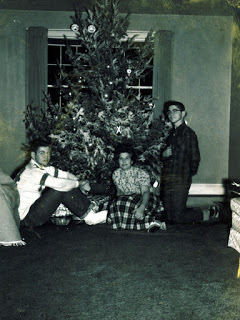 Jim, Mom, and me at Christmas, 1959. Chipper was in the tree. (photo by Dad)
Jim, Mom, and me at Christmas, 1959. Chipper was in the tree. (photo by Dad)
Published on December 23, 2018 10:04
November 13, 2018
Why I went to Virginia Tech
When I graduated from high school, I guess I was pretty full of myself because I'd managed to go off to the National Science Fair and come back with a gold and silver medal.
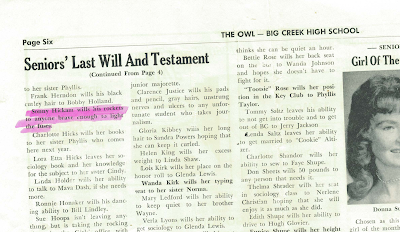 Oh, yes, I was full of myself...
Oh, yes, I was full of myself...The other rocket boys and I tucked our fingers behind our lapels and strutted around town although that didn't last long. Getting too puffed up is pretty much a West Virginia sin. Anyway, it's hard to strut around when nobody cares if you do it except yourself.
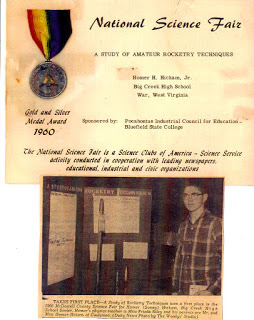 The medal and award which in my memoir and that movie was what all the fuss was about After we got over being sinful in that way, we thought we'd better thank all the people who'd helped us. That's why we set up a last day of rocket launches that I wrote about in Rocket Boys and they memorialized it, sort of different but almost the same, in the movie October Sky. It was kind of a big deal and the day had special meaning to just about everybody who was there, especially me. My dad came that day and, for the first time in forever, I think he was pretty proud I was his son. I know I was proud he was my father.
The medal and award which in my memoir and that movie was what all the fuss was about After we got over being sinful in that way, we thought we'd better thank all the people who'd helped us. That's why we set up a last day of rocket launches that I wrote about in Rocket Boys and they memorialized it, sort of different but almost the same, in the movie October Sky. It was kind of a big deal and the day had special meaning to just about everybody who was there, especially me. My dad came that day and, for the first time in forever, I think he was pretty proud I was his son. I know I was proud he was my father.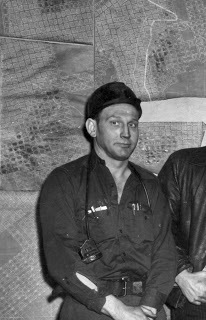 Homer H. Hickam, Sr. aka Dad and Superintendent of the Mine What I didn't write about and what the movie people didn't show you, was when I got home that day and put all the bent tubes and corroded nozzles and splintered nose cones in a corner of the basement, and Dad had gone back to work at the mine, and Mom back to work on her painting of Myrtle Beach in the kitchen, I went upstairs to my room and sat down at my desk and realized I didn't have anything to do. There was no need to build any more rockets, there was nothing to study, and I didn't have a single plan for what was supposed to happen next, mainly because of a letter that had come for me in the spring, one that I'd picked up myself at the post office without anybody else seeing it but me. It was not a happy letter and I should have done something about it but I was in the midst of building my rockets and getting ready for the science fairs and, somehow, nothing got done.
Homer H. Hickam, Sr. aka Dad and Superintendent of the Mine What I didn't write about and what the movie people didn't show you, was when I got home that day and put all the bent tubes and corroded nozzles and splintered nose cones in a corner of the basement, and Dad had gone back to work at the mine, and Mom back to work on her painting of Myrtle Beach in the kitchen, I went upstairs to my room and sat down at my desk and realized I didn't have anything to do. There was no need to build any more rockets, there was nothing to study, and I didn't have a single plan for what was supposed to happen next, mainly because of a letter that had come for me in the spring, one that I'd picked up myself at the post office without anybody else seeing it but me. It was not a happy letter and I should have done something about it but I was in the midst of building my rockets and getting ready for the science fairs and, somehow, nothing got done.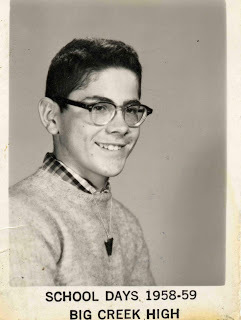 Sonny aka the Rocket Boy In such times when I had determined that I'd really messed up, it was my tendency to seek out my fellow rocket boys Roy Lee, Sherman, Billy, O'Dell, and Quentin to ask them what I should do. The problem was by the time I decided to do that, they were gone. O'Dell and Billy had joined the Air Force, Quentin lived in a town three mountains away and I had no idea where he was, and Roy Lee and Sherman had gone away to visit relatives. So there I was, stuck in Coalwood and kind of in trouble. After a couple of days of lolling around, playing with the dogs and reading novels taken from the stacks Mom and Dad kept around the house, I took a job at the gas station across the street to pump gas and change oil and put fresh tubes in tires. In the photo below, you can see the gas station with cars parked behind directly across from "The Captain's House" where we lived (the big house in the center).
Sonny aka the Rocket Boy In such times when I had determined that I'd really messed up, it was my tendency to seek out my fellow rocket boys Roy Lee, Sherman, Billy, O'Dell, and Quentin to ask them what I should do. The problem was by the time I decided to do that, they were gone. O'Dell and Billy had joined the Air Force, Quentin lived in a town three mountains away and I had no idea where he was, and Roy Lee and Sherman had gone away to visit relatives. So there I was, stuck in Coalwood and kind of in trouble. After a couple of days of lolling around, playing with the dogs and reading novels taken from the stacks Mom and Dad kept around the house, I took a job at the gas station across the street to pump gas and change oil and put fresh tubes in tires. In the photo below, you can see the gas station with cars parked behind directly across from "The Captain's House" where we lived (the big house in the center).
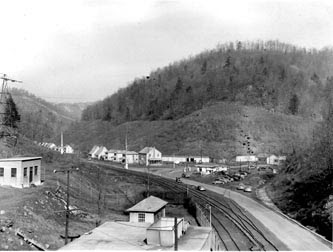 Our house and the gas station as seen from the mine
Our house and the gas station as seen from the mineMy parents didn't say a word about the fact that I was still hanging about although, eventually, I suspected they would want to know what plans I might have. One day in July, after a day at the gas station, I came into the kitchen, my hands still dirty from changing a tire, to find Mom working on her painting. She looked over from the ladder. "What now, Sonny boy? Wash your hands before you touch anything." I washed my hands in the kitchen sink, petted Lucifer our old black tom who was asleep on his back next to the refrigerator, took a deep breath, and confessed everything. "Mom, I don't know what I'm going to do now." "I thought you were waiting to hear from the Air Force Academy." "They don't want me." "Really? How's that?" "Well, it's Vice President Nixon's fault." Mom put down her paint brush and climbed down from the ladder and threw a leg over a kitchen chair and sat. "Do tell." Upon her invitation, I proceeded to remind her that I had wanted to go to the Air Force Academy but Dad wouldn't let me apply because our members of Congress were all Democrats. Instead, he'd made me apply to the Vice President, one Richard Milhous Nixon, who was a good Republican and could also nominate young men for the service academies. This I had done and, just before I'd gone off to the National Science Fair, the answer had come which was pretty much I'm sorry but you don't quite fit the bill. Of course, I would eventually exact my revenge of a sort by putting "Nick" in one of my novels.*
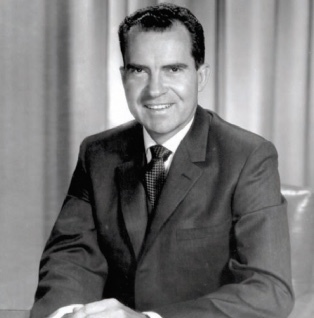 *Vice President Nixon whom I later made a major character in The Ambassador's Son Now here I was, working at a gas station with no prospects for higher education. It was quite a comedown but I deserved it. I made that clear by ending my discourse by saying "I deserve this. I should have told you and Dad." Just in case she didn't understand how really sorry I was, I added a little sniffle. During my discussion of Vice Presidents, service academies, and my general failure to plan for the future, Mom had developed sort of a cat swallowed a canary smile. "Well, here's the thing," she said. "It's not Nixon's fault, it's your dad's for making you avoid Democrats even though, just like the Republicans, they are as rascally a bunch as ever put their hands in the pockets of the working man. However, I know a sloo of 'em and I bet I coulda got you in, not that that it would have done any good. Your eyes aren't good enough. I read the health requirements. Did you?" I confessed I hadn't and watched her cat-canary smile fade into all seriousness. "You want to be an engineer, you have to go to engineer school. Heard they got a good one at VPI." VPI was the Virginia Polytechnic Institute, sometimes called Virginia Tech. I knew it fairly well because my brother Jim was going there on a football scholarship. He'd been offered to play football in a lot of colleges but had decided at first to go to West Virginia University to play for a famous coach there named Art "Pappy" Lewis that Jim idolized. But then Coach Lewis abruptly resigned and my brother, furious that he wouldn't get to play for the coach he'd wanted to play for, switched over to Virginia Tech where a few other football players he knew had decided to go.
*Vice President Nixon whom I later made a major character in The Ambassador's Son Now here I was, working at a gas station with no prospects for higher education. It was quite a comedown but I deserved it. I made that clear by ending my discourse by saying "I deserve this. I should have told you and Dad." Just in case she didn't understand how really sorry I was, I added a little sniffle. During my discussion of Vice Presidents, service academies, and my general failure to plan for the future, Mom had developed sort of a cat swallowed a canary smile. "Well, here's the thing," she said. "It's not Nixon's fault, it's your dad's for making you avoid Democrats even though, just like the Republicans, they are as rascally a bunch as ever put their hands in the pockets of the working man. However, I know a sloo of 'em and I bet I coulda got you in, not that that it would have done any good. Your eyes aren't good enough. I read the health requirements. Did you?" I confessed I hadn't and watched her cat-canary smile fade into all seriousness. "You want to be an engineer, you have to go to engineer school. Heard they got a good one at VPI." VPI was the Virginia Polytechnic Institute, sometimes called Virginia Tech. I knew it fairly well because my brother Jim was going there on a football scholarship. He'd been offered to play football in a lot of colleges but had decided at first to go to West Virginia University to play for a famous coach there named Art "Pappy" Lewis that Jim idolized. But then Coach Lewis abruptly resigned and my brother, furious that he wouldn't get to play for the coach he'd wanted to play for, switched over to Virginia Tech where a few other football players he knew had decided to go.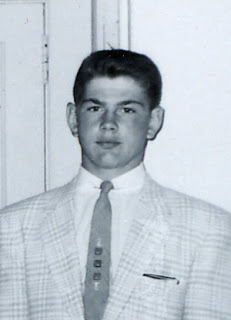 Brother Jim aka the fellow who could knock you into next Sunday on the football field
Brother Jim aka the fellow who could knock you into next Sunday on the football fieldMom added, to keep me from thinking since there was really nothing to think about, "I applied for you back in March, called down there and talked to Jimmie's coaches, and they went over to wherever they had to go and got you admitted. You're supposed to show up first week in September. All the paperwork is on the dining room table." "How did you know I didn't get in the Air Force Academy?" She didn't answer, just gave me that look that told me I had no secrets from her, not while she had access to my room and, now that I thought about it, had gone to school with the postmistress of the Coalwood post office.
 Downtown Coalwood in the 1950's And that was that. I could always count on my mother to do the best thing for me even when I didn't deserve it. I don't recall doing much to get ready to go to VPI. I didn't read the literature she'd left on the dining room table. As long as I knew the day and time I was supposed to show up there, I figured it would be just like when I first went to high school. All I did then was get on a school bus and ride for awhile and then get off and walk through the door where the teachers and the principal were waiting to tell all of us where to go, how to get there, and what was going to happen. Going to school wasn't that complicated. With the money I'd saved from working at the gas station and also previously accumulated with a newspaper route, I bought a motor scooter from Sears Roebuck. When the September date for arrival at VPI rolled around, armed with a small bag of clothes and some pens and pencils, I started the scooter up and steered it out onto the road and headed off 100 miles away to Blacksburg, Virginia. Dad was at the mine and Mom was the only one to see me off. She didn't say much. I don't think we hugged. I do remember she came out in the yard and opened the gate so I could drive through it.
Downtown Coalwood in the 1950's And that was that. I could always count on my mother to do the best thing for me even when I didn't deserve it. I don't recall doing much to get ready to go to VPI. I didn't read the literature she'd left on the dining room table. As long as I knew the day and time I was supposed to show up there, I figured it would be just like when I first went to high school. All I did then was get on a school bus and ride for awhile and then get off and walk through the door where the teachers and the principal were waiting to tell all of us where to go, how to get there, and what was going to happen. Going to school wasn't that complicated. With the money I'd saved from working at the gas station and also previously accumulated with a newspaper route, I bought a motor scooter from Sears Roebuck. When the September date for arrival at VPI rolled around, armed with a small bag of clothes and some pens and pencils, I started the scooter up and steered it out onto the road and headed off 100 miles away to Blacksburg, Virginia. Dad was at the mine and Mom was the only one to see me off. She didn't say much. I don't think we hugged. I do remember she came out in the yard and opened the gate so I could drive through it. My scooter looked like this. I thought it was cool. I still kind of do which tells you something. Once I got going, I didn't look back. Coalwood was over for me, or at least I thought it was. Although I didn't see her, I have since imagined what my mom did after she closed the gate behind me. For a while, she probably watched the place where her little Sonny boy had disappeared past the first house on Substation Row. For all I know, maybe she even shed a tear but past that, I think she turned on her heel and went into the house, there to contemplate what next she might do to save her husband and herself from the town she just could not love no matter how hard she tried. She was done with me and rightfully so. It was time for me to take care of myself.
My scooter looked like this. I thought it was cool. I still kind of do which tells you something. Once I got going, I didn't look back. Coalwood was over for me, or at least I thought it was. Although I didn't see her, I have since imagined what my mom did after she closed the gate behind me. For a while, she probably watched the place where her little Sonny boy had disappeared past the first house on Substation Row. For all I know, maybe she even shed a tear but past that, I think she turned on her heel and went into the house, there to contemplate what next she might do to save her husband and herself from the town she just could not love no matter how hard she tried. She was done with me and rightfully so. It was time for me to take care of myself. Elsie Hickam aka The Rocket Mom There was, however, a small problem. By the time I'd been accepted, all the dormitories were full and that was something even my mother couldn't fix. So I had to live in town in a basement apartment with another late applier, a fellow from California named Cecil C. Childress, III. Since I was officially Homer H. Hickam, Jr., at least in alliterative fashion, we had it covered. "Where's your uniforms, Sonny?" Cecil asked not too long after he'd welcomed me to our little underground space. I had no clue what he was talking about but, fortunately for me, it turned out Cecil knew a lot more than I did about Virginia Tech - which wasn't difficult - because his father had graduated from there and he'd been sent, mildly against his will, to repeat that experience. The uniforms I needed, he explained, were for the military units that we were both required to join. "Jim doesn't wear any uniforms," I told him. "That's because he's a football player. They don't have to be in the Corps." I had no idea what he was talking about and I revealed that by repeating his last word. "Corps?" As in the Virginia Tech Corps of Cadets which was, he explained, a completely military organization where everyone was expected to live like they were in the military and wear uniforms and march around and everything. I was astonished at this turn of events but, on the other hand, I supposed it was sort of like the Air Force Academy so maybe this wasn't so bad. The only thing was it was just so unexpected, I didn't know truly what to make of it.
Elsie Hickam aka The Rocket Mom There was, however, a small problem. By the time I'd been accepted, all the dormitories were full and that was something even my mother couldn't fix. So I had to live in town in a basement apartment with another late applier, a fellow from California named Cecil C. Childress, III. Since I was officially Homer H. Hickam, Jr., at least in alliterative fashion, we had it covered. "Where's your uniforms, Sonny?" Cecil asked not too long after he'd welcomed me to our little underground space. I had no clue what he was talking about but, fortunately for me, it turned out Cecil knew a lot more than I did about Virginia Tech - which wasn't difficult - because his father had graduated from there and he'd been sent, mildly against his will, to repeat that experience. The uniforms I needed, he explained, were for the military units that we were both required to join. "Jim doesn't wear any uniforms," I told him. "That's because he's a football player. They don't have to be in the Corps." I had no idea what he was talking about and I revealed that by repeating his last word. "Corps?" As in the Virginia Tech Corps of Cadets which was, he explained, a completely military organization where everyone was expected to live like they were in the military and wear uniforms and march around and everything. I was astonished at this turn of events but, on the other hand, I supposed it was sort of like the Air Force Academy so maybe this wasn't so bad. The only thing was it was just so unexpected, I didn't know truly what to make of it.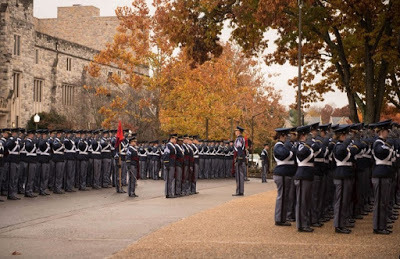 The Virginia Tech (VPI) Cadet Corps which awaited me.
The Virginia Tech (VPI) Cadet Corps which awaited me.And so it was that Cecil took me off to the cadet corps tailor shop, there to purchase two pairs of gray 100% wool shirts, two pairs of gray 100% wool pants with black stripes down their sides, one 100% wool blue dress tunic with brass insignia, one white crossbelt with brass couplet, one 100% wool overcoat, one dark blue cap with a shiny leatherette brim and a black leather strap at the base of its crown, one black rubber raincoat so thick and heavy I could barely pick it up, a white cotton belt with a wide brass buckle to go with it, and a pair of dress black leather shoes. I'd brought some cash money Mom had given me before I left and that just about depleted every cent. The white belt, Cecil explained, was called a rat belt. It was so that I could be identified as a freshmen or, according to the corps vernacular, a rat. That didn't sound good. A trip to the bookstore was next, there to buy with the little money I had left a liquid brass polisher called Brasso, something called a Blitz cloth and a jeweler's cloth to complete the brass polishing process, a wire gizmo called a Spiffy, and black Kiwi brand shoe polish, the only one, so Cecil claimed, that truly worked to properly spit shine shoes which, he said, I would need to do every day. By then, I was essentially in full zombie mode, just doing what I was told. Nothing seemed right but I guessed it was.

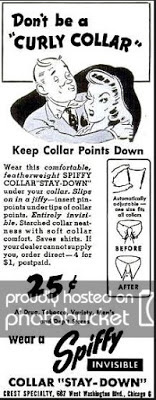
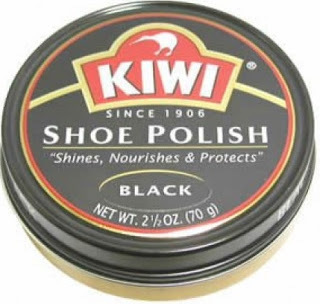
Once back to our apartment with the purchases, Cecil looked over my paperwork to see what I'd have to do next. "You're in Squadron A over at Eggleston Hall which is in the lower quad. They'll be expecting you today. Let's get you fixed up and then you better get on over there and report in." "Fixed up" required the use of all the brass polishing chemicals and implements (especially to make sure my brass belt buckle was real shiny), spit shining my shoes until I could see myself in them - Cecil showed me how and actually did most of it - and tucking my shirt into my pants so that it was flat in the back without any bagging. Cecil also showed me how to use the Spiffy to keep the tabs of the shirt collar straight and properly flat, how to wear the cap squared away with the brim no more than two fingers above my nose, and, lastly, how to walk or, as Cecil put it, to "drag right" and "square corners." This was truly mind-boggling stuff. To drag right meant to keep my right shoulder next to every wall, and to square corners meant to sharply execute a right or left turn any time I wanted to change directions. It was, Cecil said, necessary for rats to always drag right and square corners any time they were in the upper or lower quadrangles where the Corps dormitories (or barracks as they were sometimes called) were located and also inside the dorms themselves. I don't recall if I asked why this was but it didn't matter. It was and that was it. After I got dressed up, my skin crawling beneath the itchy wool of the uniform, Cecil inspected me and said, "I guess it will have to do," and pointed me in the right direction. "You either go now or they'll come after you." I went but not on my scooter. Cecil said it was illegal for a freshman to have a vehicle on campus - something else I'd kind of missed in the literature - so that meant walking. Along the way, which was about a mile, my shirt sort of came loose in the back, and I guess I handled my brass belt buckle a bit leaving behind a greasy fingerprint or two, and I walked through some mud with my shiny new shoes (which hurt, anyway), and the wind blew my cap to the back of my head. I gave none of that any thought. The lower quadrangle, where Squadron A was located, looked like an ancient castle built out of gray stone and just as forbidding. I entered it, found the quadrangle empty, and continued to the dormitory marked with a brass plaque that said Eggleston which was where Squadron A was supposed to be.
 Eggleston Hall There was a heavy wooden door which I opened and walked inside into a hallway that was so deeply polished, I could see my reflection. The smell of wax and cleansers was almost overpowering. Everything just gleamed. I spotted a fellow in a cadet uniform lounging beside a water fountain. He looked at me and his eyes widened. "Hello," I said. "I'm Sonny Hickam. I was told to report here. Do you know where I'm supposed to go?" Which was the last thing I said for a good long time mainly because for much of that good long time, I had a bucket on my head. But, oh, the adventures I was about to have over the next four years including building a giant brass cannon we decided to call the Skipper...
Eggleston Hall There was a heavy wooden door which I opened and walked inside into a hallway that was so deeply polished, I could see my reflection. The smell of wax and cleansers was almost overpowering. Everything just gleamed. I spotted a fellow in a cadet uniform lounging beside a water fountain. He looked at me and his eyes widened. "Hello," I said. "I'm Sonny Hickam. I was told to report here. Do you know where I'm supposed to go?" Which was the last thing I said for a good long time mainly because for much of that good long time, I had a bucket on my head. But, oh, the adventures I was about to have over the next four years including building a giant brass cannon we decided to call the Skipper... Cadet Sonny Hickam aka Skipper cannon boy
Cadet Sonny Hickam aka Skipper cannon boy
Published on November 13, 2018 11:52



